-
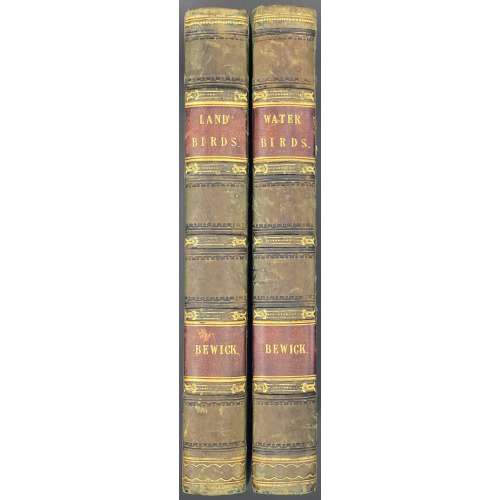 Volume 1: Land birds – 7th edition; Supplement: 1st edition. Title: A | HISTORY | OF | BRITISH BIRDS. | THE FIGURES ENGRAVED ON WOOD BY T. BEWICK. | VOL. I. | CONTAINING THE | HISTORY AND DESCRIPTION OF LAND BIRDS | — | AND | A SUPPLEMENT, WITH ADDITIONAL FIGURES. | — | NEWCASTLE: | PRINTED BY EDWARD WALKER, PILGRIM STREET, | FOR T. BEWICK : SOLD BY HIM, AND E. CHARNLEY, NEWCASTLE ; | AND LONGMAN AND CO. LONDON. | 1821. || Pagination: [2 blanks], [i, ii] – t.p. / blank, [iii] iv-xl, [43] 44-330, [2] – suppl. t.p. / blank, [1] 2-46 [47] – contents, [48] – advert., [2 blanks]. Collation: 8vo in fours; π1 A-C4 E3 F-2S4 π1 B-G4; I2, N2, and 2A2 unsigned. Woodcuts: 157 descriptions of birds, 140 figures of birds, 127 vignettes, tail-pieces, figures in text, etc. Volume 2: Water birds – 5th edition; Supplement: 1st edition. Title: A | HISTORY | OF | BRITISH BIRDS. | THE FIGURES ENGRAVED ON WOOD BY T. BEWICK. | VOL. II. | CONTAINING THE | HISTORY AND DESCRIPTION OF WATER BIRDS | — | AND | A SUPPLEMENT, WITH ADDITIONAL FIGURES. | — | NEWCASTLE: | PRINTED BY EDWARD WALKER, PILGRIM STREET, | FOR T. BEWICK : SOLD BY HIM, AND E. CHARNLEY, NEWCASTLE ; | AND LONGMAN AND CO. LONDON. | 1821. || Pagination: [2 blanks], [i, ii] – t.p. / blank, [iii] iv-xxii, [19] 20-360, [2] – suppl. t.p. / blank, [1] 2-43 [44] – contents, [1] 2-7 – addenda., [8] – imprint, [2 blanks]. Collation: 8vo in fours; π1 A-B4 *B2 C-2X4 2Y3 π1 B-F4 G2 [H]4; E2, F2, G2, 2G2, 2T2 and Suppl. G2 and Addenda unsigned. Woodcuts: 162 descriptions of birds, 125 figures of birds, 137 vignettes, tail-pieces, figures in text, etc. Both volumes: Size: 21.3 x 14 cm; page: 20.7 x 13.1 cm, demy. Binding: Green half-calf over marbled boards, blind-ruled raised bands with gilt ornament, crimson gilt-ruled and lettered labels to spine. For the first edition see: LIB-2614.2021 Catalogue raisonné: Hugo (1866): № (99) 94 –120 (108) / pp. 40-58; Roscoe (1953): № 24 a-c, 25 a-c, 26 a-c, 27 a-c, 28 / pp. 104 - 114.
Volume 1: Land birds – 7th edition; Supplement: 1st edition. Title: A | HISTORY | OF | BRITISH BIRDS. | THE FIGURES ENGRAVED ON WOOD BY T. BEWICK. | VOL. I. | CONTAINING THE | HISTORY AND DESCRIPTION OF LAND BIRDS | — | AND | A SUPPLEMENT, WITH ADDITIONAL FIGURES. | — | NEWCASTLE: | PRINTED BY EDWARD WALKER, PILGRIM STREET, | FOR T. BEWICK : SOLD BY HIM, AND E. CHARNLEY, NEWCASTLE ; | AND LONGMAN AND CO. LONDON. | 1821. || Pagination: [2 blanks], [i, ii] – t.p. / blank, [iii] iv-xl, [43] 44-330, [2] – suppl. t.p. / blank, [1] 2-46 [47] – contents, [48] – advert., [2 blanks]. Collation: 8vo in fours; π1 A-C4 E3 F-2S4 π1 B-G4; I2, N2, and 2A2 unsigned. Woodcuts: 157 descriptions of birds, 140 figures of birds, 127 vignettes, tail-pieces, figures in text, etc. Volume 2: Water birds – 5th edition; Supplement: 1st edition. Title: A | HISTORY | OF | BRITISH BIRDS. | THE FIGURES ENGRAVED ON WOOD BY T. BEWICK. | VOL. II. | CONTAINING THE | HISTORY AND DESCRIPTION OF WATER BIRDS | — | AND | A SUPPLEMENT, WITH ADDITIONAL FIGURES. | — | NEWCASTLE: | PRINTED BY EDWARD WALKER, PILGRIM STREET, | FOR T. BEWICK : SOLD BY HIM, AND E. CHARNLEY, NEWCASTLE ; | AND LONGMAN AND CO. LONDON. | 1821. || Pagination: [2 blanks], [i, ii] – t.p. / blank, [iii] iv-xxii, [19] 20-360, [2] – suppl. t.p. / blank, [1] 2-43 [44] – contents, [1] 2-7 – addenda., [8] – imprint, [2 blanks]. Collation: 8vo in fours; π1 A-B4 *B2 C-2X4 2Y3 π1 B-F4 G2 [H]4; E2, F2, G2, 2G2, 2T2 and Suppl. G2 and Addenda unsigned. Woodcuts: 162 descriptions of birds, 125 figures of birds, 137 vignettes, tail-pieces, figures in text, etc. Both volumes: Size: 21.3 x 14 cm; page: 20.7 x 13.1 cm, demy. Binding: Green half-calf over marbled boards, blind-ruled raised bands with gilt ornament, crimson gilt-ruled and lettered labels to spine. For the first edition see: LIB-2614.2021 Catalogue raisonné: Hugo (1866): № (99) 94 –120 (108) / pp. 40-58; Roscoe (1953): № 24 a-c, 25 a-c, 26 a-c, 27 a-c, 28 / pp. 104 - 114. -
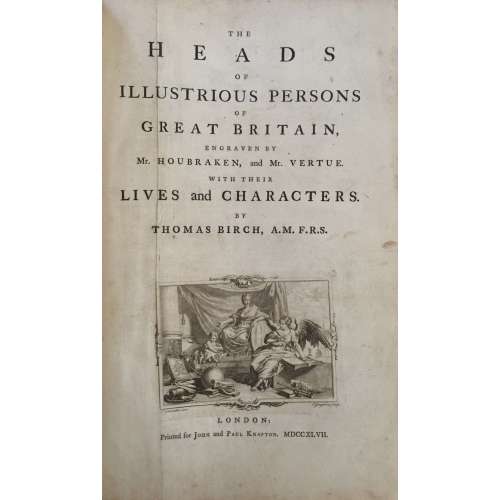
The Heads of Illustrious Persons of Great Britain Engraven By Mr. Houbraken And Mr. Vertue. With Their Lives And Characters by Thomas Birch, A.M.F.R.S. Two Volumes in One. Published for John and Paul Knapton, London, 1747. 108 engraved portraits.
-
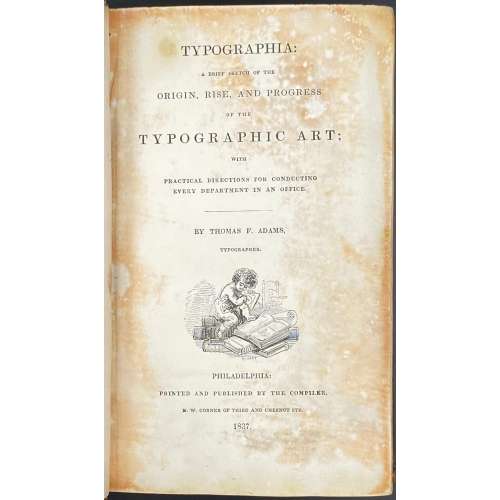 Title: TYPOGRAPHIA : | A BRIEF SKETCH OF THE | ORIGIN, RISE, AND PROGRESS | OF THE | TYPOGRAPHIC ART; | WITH | PRACTICAL DIRECTIONS FOR CONDUCTING | EVERY DEPARTMENT IN AN OFFICE. | BY THOMAS F. ADAMS, TYPOGRAPHER. | {vignette} | PHILADELPHIA: | PRINTED AND PUBLISHED BY THE COMPILER, | N. W. CORNER OF THIRD AND CHESNUT STS. | 1837. || Pagination: Engraved frontispiece w/guard, t.p. / blank, [1-3] 4-372 [8], incl. Index and Directions to binder. Collation: 12mo; 1-31(6). Binding: contemporary full brown speckled calf, flat spine bands with gilt double-fillets, dark brown lettering label. Note: Plagiarism of John Johnson's (British, 1777 – 1848) book Typographia, or, The printers' instructor published in London by Longman, Hurst, Rees, Orme, Brown & Green in 1824. .
Title: TYPOGRAPHIA : | A BRIEF SKETCH OF THE | ORIGIN, RISE, AND PROGRESS | OF THE | TYPOGRAPHIC ART; | WITH | PRACTICAL DIRECTIONS FOR CONDUCTING | EVERY DEPARTMENT IN AN OFFICE. | BY THOMAS F. ADAMS, TYPOGRAPHER. | {vignette} | PHILADELPHIA: | PRINTED AND PUBLISHED BY THE COMPILER, | N. W. CORNER OF THIRD AND CHESNUT STS. | 1837. || Pagination: Engraved frontispiece w/guard, t.p. / blank, [1-3] 4-372 [8], incl. Index and Directions to binder. Collation: 12mo; 1-31(6). Binding: contemporary full brown speckled calf, flat spine bands with gilt double-fillets, dark brown lettering label. Note: Plagiarism of John Johnson's (British, 1777 – 1848) book Typographia, or, The printers' instructor published in London by Longman, Hurst, Rees, Orme, Brown & Green in 1824. . -
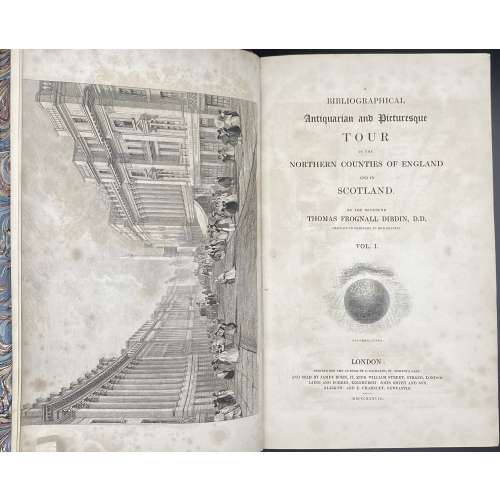 Vol. 1: A | BIBLIOGRAPHICAL | Antiquarian and Picturesque | TOUR | IN THE | NORTHERN COUNTIES OF ENGLAND | AND IN | SCOTLAND. | BY THE REVEREND | THOMAS FROGNALL DIBDIN, D.D. | CHAPLAIN IN ORDINARY TO HER MAJESTY. | VOL. I. |{device} motto: DEI OMNIA PLENA | LONDON: | PRINTED FOR THE AUTHOR BY C. RICHARDS, ST. MARTIN’S LANE : | AND SOLD BY JAMES BOHN, 12 KING WILLIAM STREET, STRAND, LONDON : | LAING AND FORBES, EDINBURGH : JOHN SMITH AND SON, | GLASGOW : AND E. CHARNLEY, NEWCASTLE. | MDCCCXXXVIII.|| Pagination: ffl, frontispiece by W. Douglas after T. M. Richardson, [i-ii] t.p. / blank; [iii-iv] - dedication to Frances Mary Richardson Currer (British, 1785 – 1861) / blank, [v] vi-xv – preface, [i] ii-xxx – supplement & index, [2] – corrections / colophon, [2] list of plates, [2] – contents, [1] 2-436, bfl; 11 plates extraneous to collation (incl. frontis.), lacking one plate (facing p. 213. “Thos. Bridges…”), in-text woodcut vignettes, head- and tailpieces. Collation: 8vo; π8 a-b8 [c2] B-Z8 2A-2E8 2F2. Vol. 2: Similar title but "VOL. II." Pagination: ffl, frontispiece portrait of Hugh Stewart, Aged 84 by Robert Bell after Alison (nothing known); [2] – t.p. / blank, [2] – contents / cont., [437-8] f.t. / blank [439] 440-1090, bfl; 453/4 misprinted 449/50; lacking list of subscribers. Collation: 8vo; π2 [2F3-2F6] 2G-2Z8 3A-3Z8. Binding: By J. Leighton, Brewer Street. Later half dark brown morocco over marbled boards, raised bands with gilt fillets, gilt titling and fillets in compartments, all edges gilt, marbled endpapers. Edition: 1st edition of Dibdin’s last major work and the only edition of this title. Size: 24.5 x 15.5 cm Provenance: Lord Ronald Gower (British, 1845 – 1916); Frank Hird (British, 1873 – 1937). Catalogue raisonné: Jackson 89; Windle & Pippin A65, pp. 179–188 [LIB-2669.2021]. Artists: Abraham, [I.] Frederic Henry (British, 1790 – 1845) Carmichael, James John Wilson (British, 1800 – 1868) Geikie, Walter (British, 1795 – 1837) Harraden, Richard Bankes (British, 1778 – 1862) Hill, David Octavius (British, 1802 –1870) McLea, John Watson (British, fl.1832-1861) Nixon, James Henry (British, b. c. 1808) Reynolds, Sir Joshua (British, 1723 – 1792) Richardson, Thomas Miles (British, 1784 – 1848) Scott, J. (British, fl. 19th c.) Wilkinson, T. M. (British, fl. 19th c.) Engravers: Aikman, Alison [spouse of George Aikman?] (British, 1788 – 1865) Bell, Robert Charles (British, 1806 – 1872) Byfield, Mary (British, 1794/5 – 1871) Douglas, William (British, 1780 – 1832) Harraden, F. (British, fl. 1838) Horsburgh, John (British, 1791 –1869) Johnstone, John (British, fl. 1835 – ) Leith & Smith, Lithogrs (Edinburgh) Lizars, William Home (British, 1788 – 1859) Miller, William (British, 1796 – 1882) Penny, William (British, fl. 19th c.) Prior, Thomas Abiel (British, 1809 – 1886) Robinson, H. (British, fl. 19th c.) Smith, Charles John (British, 1803 – 1838) Thomson, James (British, 1788 – 1850)
Vol. 1: A | BIBLIOGRAPHICAL | Antiquarian and Picturesque | TOUR | IN THE | NORTHERN COUNTIES OF ENGLAND | AND IN | SCOTLAND. | BY THE REVEREND | THOMAS FROGNALL DIBDIN, D.D. | CHAPLAIN IN ORDINARY TO HER MAJESTY. | VOL. I. |{device} motto: DEI OMNIA PLENA | LONDON: | PRINTED FOR THE AUTHOR BY C. RICHARDS, ST. MARTIN’S LANE : | AND SOLD BY JAMES BOHN, 12 KING WILLIAM STREET, STRAND, LONDON : | LAING AND FORBES, EDINBURGH : JOHN SMITH AND SON, | GLASGOW : AND E. CHARNLEY, NEWCASTLE. | MDCCCXXXVIII.|| Pagination: ffl, frontispiece by W. Douglas after T. M. Richardson, [i-ii] t.p. / blank; [iii-iv] - dedication to Frances Mary Richardson Currer (British, 1785 – 1861) / blank, [v] vi-xv – preface, [i] ii-xxx – supplement & index, [2] – corrections / colophon, [2] list of plates, [2] – contents, [1] 2-436, bfl; 11 plates extraneous to collation (incl. frontis.), lacking one plate (facing p. 213. “Thos. Bridges…”), in-text woodcut vignettes, head- and tailpieces. Collation: 8vo; π8 a-b8 [c2] B-Z8 2A-2E8 2F2. Vol. 2: Similar title but "VOL. II." Pagination: ffl, frontispiece portrait of Hugh Stewart, Aged 84 by Robert Bell after Alison (nothing known); [2] – t.p. / blank, [2] – contents / cont., [437-8] f.t. / blank [439] 440-1090, bfl; 453/4 misprinted 449/50; lacking list of subscribers. Collation: 8vo; π2 [2F3-2F6] 2G-2Z8 3A-3Z8. Binding: By J. Leighton, Brewer Street. Later half dark brown morocco over marbled boards, raised bands with gilt fillets, gilt titling and fillets in compartments, all edges gilt, marbled endpapers. Edition: 1st edition of Dibdin’s last major work and the only edition of this title. Size: 24.5 x 15.5 cm Provenance: Lord Ronald Gower (British, 1845 – 1916); Frank Hird (British, 1873 – 1937). Catalogue raisonné: Jackson 89; Windle & Pippin A65, pp. 179–188 [LIB-2669.2021]. Artists: Abraham, [I.] Frederic Henry (British, 1790 – 1845) Carmichael, James John Wilson (British, 1800 – 1868) Geikie, Walter (British, 1795 – 1837) Harraden, Richard Bankes (British, 1778 – 1862) Hill, David Octavius (British, 1802 –1870) McLea, John Watson (British, fl.1832-1861) Nixon, James Henry (British, b. c. 1808) Reynolds, Sir Joshua (British, 1723 – 1792) Richardson, Thomas Miles (British, 1784 – 1848) Scott, J. (British, fl. 19th c.) Wilkinson, T. M. (British, fl. 19th c.) Engravers: Aikman, Alison [spouse of George Aikman?] (British, 1788 – 1865) Bell, Robert Charles (British, 1806 – 1872) Byfield, Mary (British, 1794/5 – 1871) Douglas, William (British, 1780 – 1832) Harraden, F. (British, fl. 1838) Horsburgh, John (British, 1791 –1869) Johnstone, John (British, fl. 1835 – ) Leith & Smith, Lithogrs (Edinburgh) Lizars, William Home (British, 1788 – 1859) Miller, William (British, 1796 – 1882) Penny, William (British, fl. 19th c.) Prior, Thomas Abiel (British, 1809 – 1886) Robinson, H. (British, fl. 19th c.) Smith, Charles John (British, 1803 – 1838) Thomson, James (British, 1788 – 1850) -
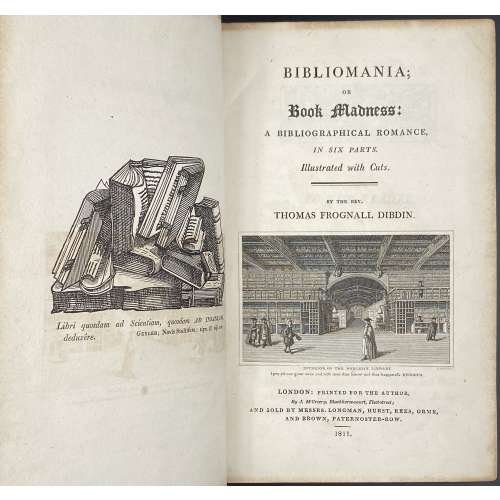 Title: BIBLIOMANIA; | OR | Book Madness: | A BIBLIOGRAPHICAL ROMANCE, | IN SIX PARTS. | Illustrated with Cuts. | BY THE REV. | THOMAS FROGNALL DIBDIN. | {vignette} | INTERIOR OF THE BODLEIAN LIBRARY | I pity all our great ones and rich men that know not this happiness. HEINSIUS. | LONDON: PRINTED FOR THE AUTHOR, | By J. McCreery, Blackhorse-court, Fleet-street; | AND SOLD BY MESSRS. LONGMAN, HURST, REES, ORME, | AND BROWN, PATERNOSTER-ROW. | 1811.|| Pagination: ffl, [i, ii] - ht, frontis., [iii, iv] - t.p., blank, [v]vi-ix - to the reader, [x] - blank, [2] - contents, [1, 2] - part 1 fl. t.p., blank, [3] - woodcut frame and capital I, 4-782 (imprint to p. 782) [2] - errata, blank, bfl; 1 plate op. p. 158. Collation: [A]6 B-Z8 2A-2Z8, 3A-3B8, 3C-3F4. Binding: 8vo, 23 x 14 cm, modern full dark brown calf by Period Binders (Bath, England), gilt fillet border to boards, raised bands with gilt ornaments and lettering to spine, pp. 685-688 an open tear in upper 1/8 of lateral margin, all margins marbled. Substantially revised 1st edition ("so much altered and enlarged, as to assume the character of a new work"). Author: Thomas Frognall Dibdin (British, 1776 – 1847).
Title: BIBLIOMANIA; | OR | Book Madness: | A BIBLIOGRAPHICAL ROMANCE, | IN SIX PARTS. | Illustrated with Cuts. | BY THE REV. | THOMAS FROGNALL DIBDIN. | {vignette} | INTERIOR OF THE BODLEIAN LIBRARY | I pity all our great ones and rich men that know not this happiness. HEINSIUS. | LONDON: PRINTED FOR THE AUTHOR, | By J. McCreery, Blackhorse-court, Fleet-street; | AND SOLD BY MESSRS. LONGMAN, HURST, REES, ORME, | AND BROWN, PATERNOSTER-ROW. | 1811.|| Pagination: ffl, [i, ii] - ht, frontis., [iii, iv] - t.p., blank, [v]vi-ix - to the reader, [x] - blank, [2] - contents, [1, 2] - part 1 fl. t.p., blank, [3] - woodcut frame and capital I, 4-782 (imprint to p. 782) [2] - errata, blank, bfl; 1 plate op. p. 158. Collation: [A]6 B-Z8 2A-2Z8, 3A-3B8, 3C-3F4. Binding: 8vo, 23 x 14 cm, modern full dark brown calf by Period Binders (Bath, England), gilt fillet border to boards, raised bands with gilt ornaments and lettering to spine, pp. 685-688 an open tear in upper 1/8 of lateral margin, all margins marbled. Substantially revised 1st edition ("so much altered and enlarged, as to assume the character of a new work"). Author: Thomas Frognall Dibdin (British, 1776 – 1847). -
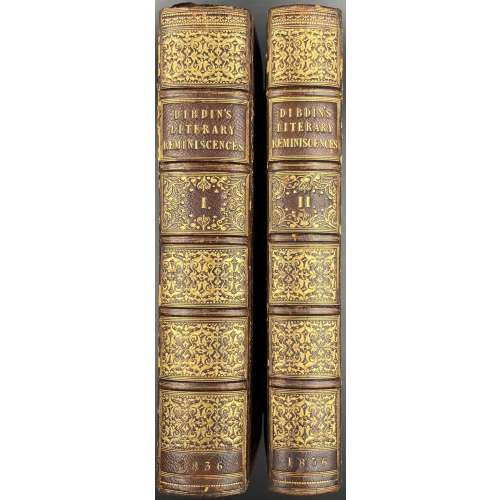 Two volumes uniformly bound by J. Mackenzie, in brown straight-grain morocco, boards with 7 gilt fillet border, fleuron corners, spine with raised bands, gilt in compartments, gilt-lettered DIBDIN’S | LITERARY | REMINISCENCES | I (or) II | 1836. All margins gilt, cream endpapers, armorial bookplate of William Henry Rossington to the front pastedown. Vol. 1: Title page: REMINISCENCES | OF | A LITERARY LIFE; | BY THE REVEREND | THOS. FROGNALL DIBDIN, D.D. | {vignette} | {one line citation | Richard de Bury} | LONDON: | JOHN MAJOR, 71, GREAT RUSSELL-STREET, | BLOOMSBURY. | MDCCCXXXVI. || Pagination: [4] two blank leaves, [i-v] vi-xxxii [4] list of plates, corrections, [1] 2-556 [4] two blank leaves. Collation: 8vo; [a]8 b8 [c]2, B-Z8, AA-MM8 NN6, 5 plates (incl. frontis. portrait by James Posselwhite after George Richmond) extraneous to collation, and a few vignettes in text. Vol. 2: Title page: REMINISCENCES | OF | A LITERARY LIFE; | WITH ANECDOTES OF BOOKS, | AND OF | BOOK COLLECTORS: | BY THE REVEREND | THOS. FROGNALL DIBDIN, D.D. | PART THE SECOND. | LONDON: | JOHN MAJOR, 71, GREAT RUSSELL-STREET, | BLOOMSBURY. | MDCCCXXXVI. || Pagination: [4] two blank leaves, [2] title/blank, 557-982, [1-3] 4-44 index, [4] two blank leaves. Collation: 8vo; [NN]2 OO-ZZ8 3A-3Q8 3R3, B-C8 D4, 5 plates (incl. frontis. “The Library, Eshton Hall”) extraneous to collation, and a few vignettes in text. Catalogue raisonné: Windle, Pippin (1999): A62 / pp. 171-177. Contributors: Author: Thomas Frognall Dibdin (British, 1776 – 1847) Artists: George Richmond (British, 1809 – 1896); Mary Dawson Turner [neé Mary Palgrave] (British, 1774 – 1850); Frederick Mackenzie (British, 1788? – 1854); C. J. Stewart (British, fl. 1830s). Copper engravers: James Posselwhite (British, 1798-1884); Philip Audinet (British, 1766 – 1837); William Henry Worthington. (British, c. 1790 – after 1839); Samuel Rawle (British, 1771 – 1860); Samuel Freeman (British, 1773 – 1857); James Thomson (British, 1788–1850). Wood engravings by John Byfield (British, 1788-1841) and his sister Mary Byfield (British, 1795 – 1871). Printer: William Wilcockson, Rolls Buildings, Fetter Lane. Publisher: John Major (British, 1782 – 1849) Binder: John Mackenzie (British, 1788 – c.1850) – held the office of bookbinder to both King George IV and King William IV. Bookplate: Colonel William Henry Rossington (American, 1848 – 1908)
Two volumes uniformly bound by J. Mackenzie, in brown straight-grain morocco, boards with 7 gilt fillet border, fleuron corners, spine with raised bands, gilt in compartments, gilt-lettered DIBDIN’S | LITERARY | REMINISCENCES | I (or) II | 1836. All margins gilt, cream endpapers, armorial bookplate of William Henry Rossington to the front pastedown. Vol. 1: Title page: REMINISCENCES | OF | A LITERARY LIFE; | BY THE REVEREND | THOS. FROGNALL DIBDIN, D.D. | {vignette} | {one line citation | Richard de Bury} | LONDON: | JOHN MAJOR, 71, GREAT RUSSELL-STREET, | BLOOMSBURY. | MDCCCXXXVI. || Pagination: [4] two blank leaves, [i-v] vi-xxxii [4] list of plates, corrections, [1] 2-556 [4] two blank leaves. Collation: 8vo; [a]8 b8 [c]2, B-Z8, AA-MM8 NN6, 5 plates (incl. frontis. portrait by James Posselwhite after George Richmond) extraneous to collation, and a few vignettes in text. Vol. 2: Title page: REMINISCENCES | OF | A LITERARY LIFE; | WITH ANECDOTES OF BOOKS, | AND OF | BOOK COLLECTORS: | BY THE REVEREND | THOS. FROGNALL DIBDIN, D.D. | PART THE SECOND. | LONDON: | JOHN MAJOR, 71, GREAT RUSSELL-STREET, | BLOOMSBURY. | MDCCCXXXVI. || Pagination: [4] two blank leaves, [2] title/blank, 557-982, [1-3] 4-44 index, [4] two blank leaves. Collation: 8vo; [NN]2 OO-ZZ8 3A-3Q8 3R3, B-C8 D4, 5 plates (incl. frontis. “The Library, Eshton Hall”) extraneous to collation, and a few vignettes in text. Catalogue raisonné: Windle, Pippin (1999): A62 / pp. 171-177. Contributors: Author: Thomas Frognall Dibdin (British, 1776 – 1847) Artists: George Richmond (British, 1809 – 1896); Mary Dawson Turner [neé Mary Palgrave] (British, 1774 – 1850); Frederick Mackenzie (British, 1788? – 1854); C. J. Stewart (British, fl. 1830s). Copper engravers: James Posselwhite (British, 1798-1884); Philip Audinet (British, 1766 – 1837); William Henry Worthington. (British, c. 1790 – after 1839); Samuel Rawle (British, 1771 – 1860); Samuel Freeman (British, 1773 – 1857); James Thomson (British, 1788–1850). Wood engravings by John Byfield (British, 1788-1841) and his sister Mary Byfield (British, 1795 – 1871). Printer: William Wilcockson, Rolls Buildings, Fetter Lane. Publisher: John Major (British, 1782 – 1849) Binder: John Mackenzie (British, 1788 – c.1850) – held the office of bookbinder to both King George IV and King William IV. Bookplate: Colonel William Henry Rossington (American, 1848 – 1908) -
 A two-volume set: (1) Thomas Hugo. The Bewick Collector. A Descriptive Catalogue of the Works of Thomas and John Bewick; Including cuts, in various states, for Books and Pamphlets, Private Gentlemen, Public Companies, Exhibitions, Races, Newspapers, Shop Cards, Invoice Heads, Bar Bills, Coal Certificates, Broadsides, and other miscellaneous purposes, and Wood Blocks. With an Appendix of Portraits, Autographs, Works of Pupils, etc., etc. The whole described from the Originals contained in the largest and most perfect collection ever formed, and illustrated with a hundred and twelve cuts. — London: Lovell Reeve and Co., MDCCCLXVI [1866]. — [Printed by] J. E. Taylor and Co., printers. — pp.: [i-v] vi-xxiii [xxiv], [1] 2-562. (2) Thomas Hugo. The Bewick Collector. A Supplement to a Descriptive Catalogue of the Works of Thomas and John Bewick; Consisting of additions to the various divisions of cuts, wood blocks. etc., enumerated in that work. The whole described from the Originals contained in the largest and most perfect collection ever formed, and illustrated with a hundred and eighty cuts. — London: L. Reeve and Co, MDCCCLXVIII [1868]. — [Printed by] J. E. Taylor and Co., printers. — pp.: [i-vii] viii-xxxii, [1] 2-353. Both volumes in 8vo, 22.5 x 14.5 cm, hardcover. Contemporary dark brown half morocco, gilt-ruled, with 5 raised bands, gilt titles and decoration to spine, and marbled paper over boards. Top edge gilt; marbled endpapers. Binding splitting at pp.80/81 of the 1st volume. Armorial bookplate of Ralph Hart Tweddle to front pastedown. Ralph Hart Tweddle (1843 – 1895) was a British mechanical engineer, known particularly for inventing the portable hydraulic riveter, which greatly facilitated the construction of boilers, bridges and ships.
A two-volume set: (1) Thomas Hugo. The Bewick Collector. A Descriptive Catalogue of the Works of Thomas and John Bewick; Including cuts, in various states, for Books and Pamphlets, Private Gentlemen, Public Companies, Exhibitions, Races, Newspapers, Shop Cards, Invoice Heads, Bar Bills, Coal Certificates, Broadsides, and other miscellaneous purposes, and Wood Blocks. With an Appendix of Portraits, Autographs, Works of Pupils, etc., etc. The whole described from the Originals contained in the largest and most perfect collection ever formed, and illustrated with a hundred and twelve cuts. — London: Lovell Reeve and Co., MDCCCLXVI [1866]. — [Printed by] J. E. Taylor and Co., printers. — pp.: [i-v] vi-xxiii [xxiv], [1] 2-562. (2) Thomas Hugo. The Bewick Collector. A Supplement to a Descriptive Catalogue of the Works of Thomas and John Bewick; Consisting of additions to the various divisions of cuts, wood blocks. etc., enumerated in that work. The whole described from the Originals contained in the largest and most perfect collection ever formed, and illustrated with a hundred and eighty cuts. — London: L. Reeve and Co, MDCCCLXVIII [1868]. — [Printed by] J. E. Taylor and Co., printers. — pp.: [i-vii] viii-xxxii, [1] 2-353. Both volumes in 8vo, 22.5 x 14.5 cm, hardcover. Contemporary dark brown half morocco, gilt-ruled, with 5 raised bands, gilt titles and decoration to spine, and marbled paper over boards. Top edge gilt; marbled endpapers. Binding splitting at pp.80/81 of the 1st volume. Armorial bookplate of Ralph Hart Tweddle to front pastedown. Ralph Hart Tweddle (1843 – 1895) was a British mechanical engineer, known particularly for inventing the portable hydraulic riveter, which greatly facilitated the construction of boilers, bridges and ships. -
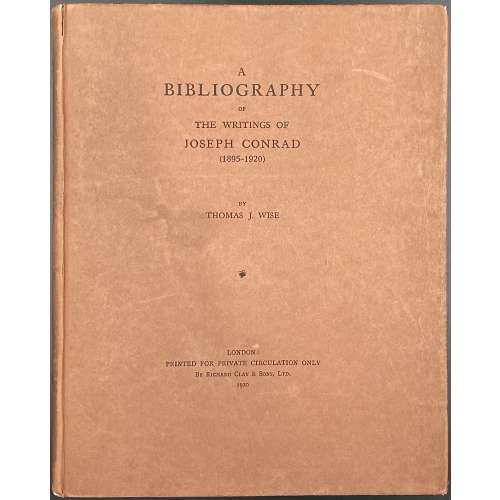 Title page: A | BIBLIOGRAPHY | OF | THE WRITINGS OF | JOSEPH CONRAD (1895–1920) | BY THOMAS J. WISE | ❦ | LONDON: | PRINTED FOR PRIVATE CIRCULATION ONLY | By Richard Clay & Sons, Ltd. | 1920 || Pagination: [i-viii] ix-xiii [xiv-xvi], [1, 2] 3-105 [106-112], frontispiece with tissue guard in collation; 128 pages total. Collation: 8vo; [A]-H8, 64 leaves total. Binding: 22.5 x 18 cm; terracotta paper boards, black lettering to front and spine; uncut. The device on the recto of the last leaf inscribed: The Ashley library. Privately printed. 1920. Insert: ALS from Thomas J. Wise dated 22/3/21 on watermarked paper (King of Kent | Extra Fine) with letterhead “Kirkstead”, 25 Heath Drive, Hampstead, N.W.3. The letter is a response to a request for two copies of Volume II of Wise’s Swinburne bibliography, which Wise promises to supply the next day to Stevens & Brown (founded in 1864, Literary and Fine Arts Agents). Limitation: 150 copies, private printing. Contributors: Joseph Conrad [Józef Teodor Konrad Korzeniowski] (British-Polish, 1857 – 1924) Wise, Thomas James (British, 1859 – 1937) – compiler, bibliographer. R. Clay & Sons Ltd. (London); Clay, Richard (British, 1789 – 1877) – publisher. The Ashley Library (London) – printer.
Title page: A | BIBLIOGRAPHY | OF | THE WRITINGS OF | JOSEPH CONRAD (1895–1920) | BY THOMAS J. WISE | ❦ | LONDON: | PRINTED FOR PRIVATE CIRCULATION ONLY | By Richard Clay & Sons, Ltd. | 1920 || Pagination: [i-viii] ix-xiii [xiv-xvi], [1, 2] 3-105 [106-112], frontispiece with tissue guard in collation; 128 pages total. Collation: 8vo; [A]-H8, 64 leaves total. Binding: 22.5 x 18 cm; terracotta paper boards, black lettering to front and spine; uncut. The device on the recto of the last leaf inscribed: The Ashley library. Privately printed. 1920. Insert: ALS from Thomas J. Wise dated 22/3/21 on watermarked paper (King of Kent | Extra Fine) with letterhead “Kirkstead”, 25 Heath Drive, Hampstead, N.W.3. The letter is a response to a request for two copies of Volume II of Wise’s Swinburne bibliography, which Wise promises to supply the next day to Stevens & Brown (founded in 1864, Literary and Fine Arts Agents). Limitation: 150 copies, private printing. Contributors: Joseph Conrad [Józef Teodor Konrad Korzeniowski] (British-Polish, 1857 – 1924) Wise, Thomas James (British, 1859 – 1937) – compiler, bibliographer. R. Clay & Sons Ltd. (London); Clay, Richard (British, 1789 – 1877) – publisher. The Ashley Library (London) – printer. -
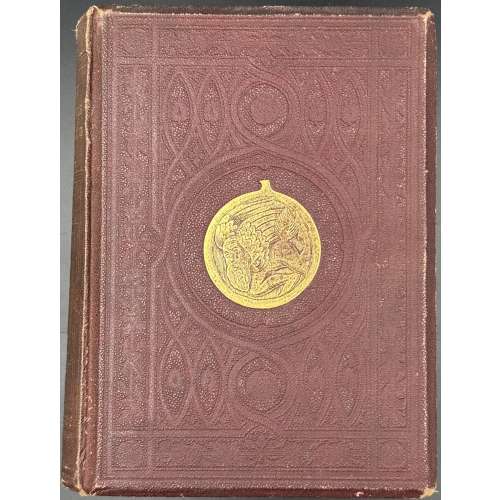 Hardcover, 23 x 17 x 4.7 cm, burgundy buckram, bevelled boards, blind geometrical design with a gilt medallion at the centre, gilt lettering and blind design elements to spine, text in frame, all edges red; pp.: [i-v] vi-xvi, [1] 2-494, [2 advert.], [1] 2-32 advert.], collation 4to: a-b4, B-3R4, a16. Title-page (red and black, in red frame): A HISTORY | OF | CARICATURE & GROTESQUE | {gothic letters} In Literature and Art. | By THOMAS WRIGHT, Esq., M.A., F.S.A., | Hon. M.R.S.L., &c.; | Corresponding Member of the Imperial Institute of France | (Académie des Inscriptions et Belles Lettres). |{double rules} | WITH | ILLUSTRATIONS FROM VARIOUS SOURCES, | DRAWN AND ENGRAVED BY | F. W. FAIRHOLT, Esq., F.S.A. | {double rules} | {gothic letters} London : | VIRTUE BROTHERS & CO., 1, AMEN CORNER, | PATERNOSTER ROW. | 1865. Contributors : Thomas Wright (British, 1792 – 1849) – author. Frederick William Fairholt (British, 1814 – 1866) – artist/engraver. Virtue Brothers & Co. (London) – publisher/printer.
Hardcover, 23 x 17 x 4.7 cm, burgundy buckram, bevelled boards, blind geometrical design with a gilt medallion at the centre, gilt lettering and blind design elements to spine, text in frame, all edges red; pp.: [i-v] vi-xvi, [1] 2-494, [2 advert.], [1] 2-32 advert.], collation 4to: a-b4, B-3R4, a16. Title-page (red and black, in red frame): A HISTORY | OF | CARICATURE & GROTESQUE | {gothic letters} In Literature and Art. | By THOMAS WRIGHT, Esq., M.A., F.S.A., | Hon. M.R.S.L., &c.; | Corresponding Member of the Imperial Institute of France | (Académie des Inscriptions et Belles Lettres). |{double rules} | WITH | ILLUSTRATIONS FROM VARIOUS SOURCES, | DRAWN AND ENGRAVED BY | F. W. FAIRHOLT, Esq., F.S.A. | {double rules} | {gothic letters} London : | VIRTUE BROTHERS & CO., 1, AMEN CORNER, | PATERNOSTER ROW. | 1865. Contributors : Thomas Wright (British, 1792 – 1849) – author. Frederick William Fairholt (British, 1814 – 1866) – artist/engraver. Virtue Brothers & Co. (London) – publisher/printer. -
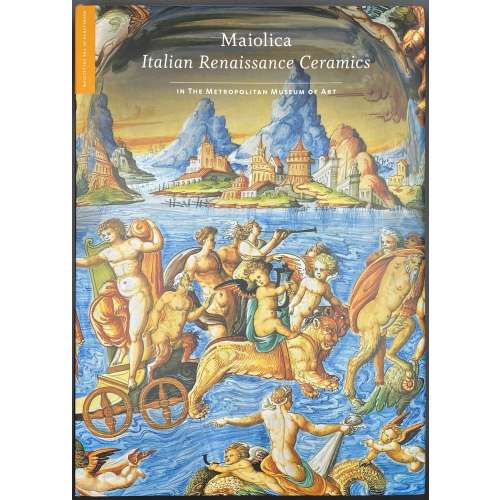 Title page: HIGHLIGHTS of the COLLECTION | Maiolica: Italian Renaissance Ceramics | IN THE METROPOLITAN MUSEUM OF ART | Timothy Wilson | with an essay by Luke Syson | {publisher’s device}| The Metropolitan Museum of Art, New York | DISTRIBUTED BY YALE UNIVERSITY PRESS | NEW HAVEN AND LONDON || Pagination: [i-v] vi-xi [xii] [1, 2] 3-380. New/mint. Binding: 31 x 22.5 cm, blue cloth with gilt lettering to spine, pictorial DJ.
Title page: HIGHLIGHTS of the COLLECTION | Maiolica: Italian Renaissance Ceramics | IN THE METROPOLITAN MUSEUM OF ART | Timothy Wilson | with an essay by Luke Syson | {publisher’s device}| The Metropolitan Museum of Art, New York | DISTRIBUTED BY YALE UNIVERSITY PRESS | NEW HAVEN AND LONDON || Pagination: [i-v] vi-xi [xii] [1, 2] 3-380. New/mint. Binding: 31 x 22.5 cm, blue cloth with gilt lettering to spine, pictorial DJ. -
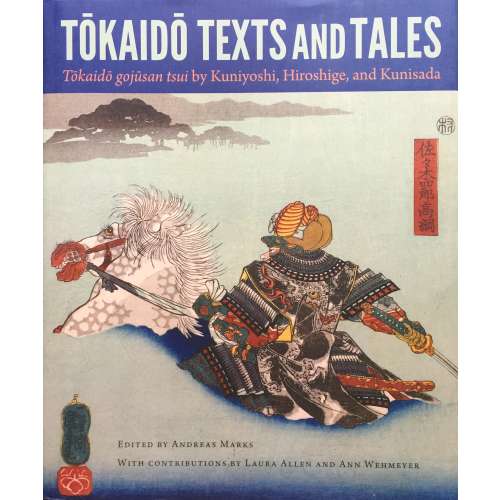
Hardcover, green cloth stamped with title to front cover and spine, pictorial DJ, pp.: [10] 1-206.
Introduction / Andreas Marks -- An artistic collaboration: travelling the Tōkaidō with Kuniyoshi, Hiroshige, and Kunisada / Laura W. Allen Folklore and legend in the fifty-three pairings along the Tōkaidō / Ann Wehmeyer The plates. Tōkaidō gojūsan tsui / transcription and translation by Ann Wehmeyer ; notes by Ann Wehmeyer and Andreas Marks.ISBN: 9780813060217
-
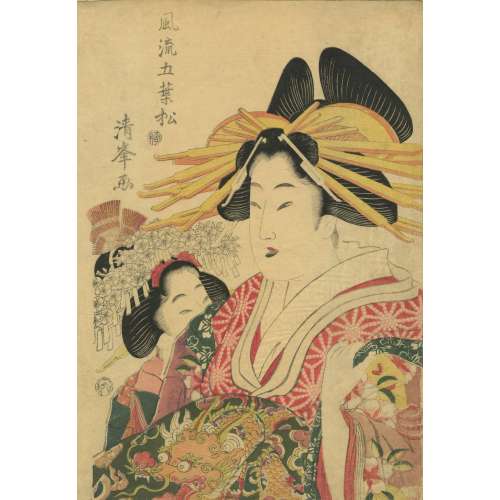 Torii Kiyomitsu II (Kiyomine), Japanese, 1787–1868. Courtesan and her Komura (Doll Festival). Series: Furyu Goyo no Matsu (Customs of 5 Pine Needles, the 5 great festivals). Publisher: Tsuruya Kiemon [Marks: 553].
Torii Kiyomitsu II (Kiyomine), Japanese, 1787–1868. Courtesan and her Komura (Doll Festival). Series: Furyu Goyo no Matsu (Customs of 5 Pine Needles, the 5 great festivals). Publisher: Tsuruya Kiemon [Marks: 553]. -
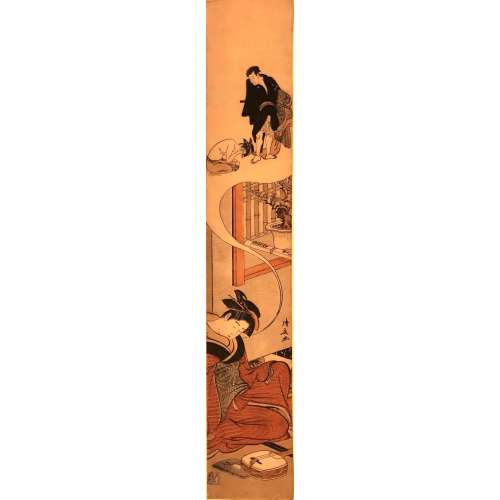 Torii Kiyonaga (1752-1815) Color woodblock print: hashira-e, 68.9 x 12.1 cm. DATE: 1783. Signed: Kiyonaga ga Publisher: Eijudō (Nishimuraya Yohachi) "Young musician dreams of being abducted by a ruffian. Long hours on duty have exhausted this young musician who sits sleeping with her shamisen and book placed on the ground in front of her. In her dream, she is being abducted by a ruffian who has stripped her of her clothing" [LIB-1474.2018: Important Japanese prints from the collection of Henry Steiner. Catalogue № 14. — NY: Sebastian Izzard LLC, 2018.]
Torii Kiyonaga (1752-1815) Color woodblock print: hashira-e, 68.9 x 12.1 cm. DATE: 1783. Signed: Kiyonaga ga Publisher: Eijudō (Nishimuraya Yohachi) "Young musician dreams of being abducted by a ruffian. Long hours on duty have exhausted this young musician who sits sleeping with her shamisen and book placed on the ground in front of her. In her dream, she is being abducted by a ruffian who has stripped her of her clothing" [LIB-1474.2018: Important Japanese prints from the collection of Henry Steiner. Catalogue № 14. — NY: Sebastian Izzard LLC, 2018.]The Japanese Pillar Print. Hashira-e. Jacob Pins. Foreword by Roger Keyes. Robert G. Sawers Publishing, London, 1982 [LIB-1543.2018 in this collection] -> page 262 №703: A young woman dreaming of rape and robbery. 1783. Hirano.
MFA: ACCESSION NUMBER 21.5546: Young Woman Music Teacher Dreaming of a Robbery [追剥の夢を見る三味線師匠]. Edo period, about 1783 (Tenmei 3). Artist Torii Kiyonaga (1752–1815), Publisher Nishimuraya Yohachi (Eijudô). Harvard Museums Object Number 1916.586: Female Musician Dreaming of Robbery. Edo period, circa 1783. Torii Kiyonaga, Japanese (1752 - 1815) . Published by Nishimuraya Yohachi. -
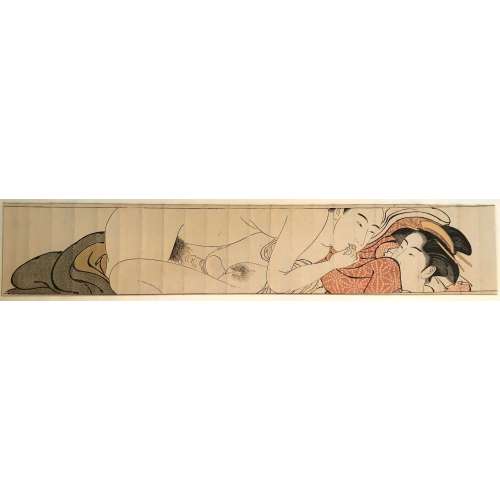 Artist: Torii Kiyonaga [鳥居 清長] (Japanese, 1752 – 1815) Color woodblock print: makimono-e (11.4 x 65.4 cm). Year: c. 1785. Three sheets of the series of twelve, № 6, № 9, and № 11, "from Kiyonaga's most idiosyncratic and celebrated series of pornography. It was designed as part of a miniature handscroll (makimono) to place in one's sleeve, where it was carried both for its stimulatory and for its talismanic properties." [LIB-1474.2018] Important Japanese prints from the collection of Henry Steiner by Sebastian Izzard.]№ 6: "The woman's blackened teeth indicate that she is a wife. This middle-aged couple is relaxing and drowsing after lovemaking. The scene is peaceful now., but the pillow cast aside hints at their earlier, passionate lovemaking".
Artist: Torii Kiyonaga [鳥居 清長] (Japanese, 1752 – 1815) Color woodblock print: makimono-e (11.4 x 65.4 cm). Year: c. 1785. Three sheets of the series of twelve, № 6, № 9, and № 11, "from Kiyonaga's most idiosyncratic and celebrated series of pornography. It was designed as part of a miniature handscroll (makimono) to place in one's sleeve, where it was carried both for its stimulatory and for its talismanic properties." [LIB-1474.2018] Important Japanese prints from the collection of Henry Steiner by Sebastian Izzard.]№ 6: "The woman's blackened teeth indicate that she is a wife. This middle-aged couple is relaxing and drowsing after lovemaking. The scene is peaceful now., but the pillow cast aside hints at their earlier, passionate lovemaking".
Picture № 6. (31d in LIB-2971.2022)
№ 9: "This looks to be the first sexual experience of a young woman of a well-to-do family, who covers her mouth shyly. The more experienced man moistens his fingers with saliva, eager to explore the young woman's body".
Picture № 9.
№ 11: "The woman wears a so-called Iwata sash signalling that she is pregnant. The man approaches from behind so as not to put pressure on her stomach. He shows care and gentle consideration toward his pregnant wife, who appears relaxed". Picture descriptions from Shunga: Sex and Pleasure in Japanese art. Edited by Timothy Clark, C. Andrew Gerstle, Aki Ishigami, Akiki Yano. Hotei Publishing, 2013. Ref.: [LIB-2971.2022] Chris Uhlenbeck, Margarita Winkel. Japanese erotic fantasies sexual imagery of the Edo period. — Amsterdam: Hotei Publishing, ©2005; p. 118-9 (№ 31).
Picture № 11. (31g in LIB-2971.2022)
-
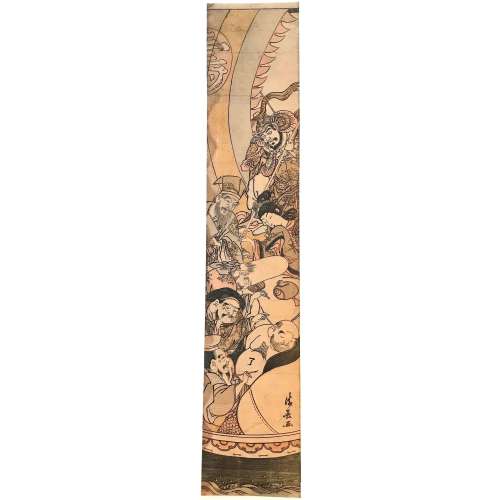 Torii Kiyonaga (鳥居 清長; 1752 – June 28, 1815) Signed: Kiyonaga ga (清長画)
Torii Kiyonaga (鳥居 清長; 1752 – June 28, 1815) Signed: Kiyonaga ga (清長画)References: No references whatsoever, not in Pins.
-
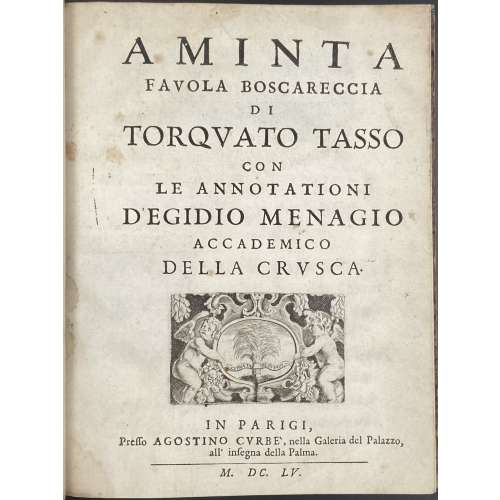 Title-page: AMINTA | FAVOLA BOSCARECCIA | DI | TORQUATO TASSO | CON | LE ANNOTATIONI | D'EGIDIO MENAGIO | ACCADEMICO | DELLA CRVSCA• | {woodcut vignette} | IN PARIGI| Presso AGOSTINO Cvrbe`, nella Galeria del Palazzo, | all’ insegna della Palma. |—| M. DC. LV. || Collation: 4to; ā4 ē4 ī4 A2 B2 C-V4 Y-Z4 2A1,2 X4 2A3,4 2B-2Z4, 3A-3B4, total number of leaves = 200. Note: O2, 2K3, 2V3 2X3 2Y3, and 3B3 – unsigned, 2Z3 signed 2Z2 (Zzij), quire X (pp. 145-152) bound between 2A2 (p. 172) and 2A3 (p. 173); illustrated throughout with woodcut head- and tailpieces and initials, Atto Primo has copperplate engraved historiated initial and a headpiece signed “F. C. in. — I. B. fe.” “I. B.” was a monogram of engraver Giulio Bonasone (Italian, c. 1498 – after 1574). Pagination: [2] – t.p. / blank, [8] – dedication, i-xviii, [4], 1-341 [342-368]; total number of pages = 400. Binding: 22.3 x 18 cm, 19th-century quarter morocco over marbled boards, spine with raised bands and gilt lettering, rebacked, additional blank flyleaves at front and back, marbled endpapers and all edges. Bookplate to front pastedown: “The Robin Collection”. Verso front flyleaf stamped “RESTORED BY MACDONALD CO. | NORWALK. CONN. Provenance: The Robin Collection. Contributors: Torquato Tasso (Italian, 1544 –1595) – author. Gilles Ménage (French, 1613 – 1692) – author. Antoine Vitré (French, 1595 – 1674) – printer. Augustin Courbé (French, fl. c. 1625 – 1660) – publisher. Marie-Madeleine Pioche de La Vergne, comtesse de La Fayette (French, 1634 – 1693) – dedicatee.
Title-page: AMINTA | FAVOLA BOSCARECCIA | DI | TORQUATO TASSO | CON | LE ANNOTATIONI | D'EGIDIO MENAGIO | ACCADEMICO | DELLA CRVSCA• | {woodcut vignette} | IN PARIGI| Presso AGOSTINO Cvrbe`, nella Galeria del Palazzo, | all’ insegna della Palma. |—| M. DC. LV. || Collation: 4to; ā4 ē4 ī4 A2 B2 C-V4 Y-Z4 2A1,2 X4 2A3,4 2B-2Z4, 3A-3B4, total number of leaves = 200. Note: O2, 2K3, 2V3 2X3 2Y3, and 3B3 – unsigned, 2Z3 signed 2Z2 (Zzij), quire X (pp. 145-152) bound between 2A2 (p. 172) and 2A3 (p. 173); illustrated throughout with woodcut head- and tailpieces and initials, Atto Primo has copperplate engraved historiated initial and a headpiece signed “F. C. in. — I. B. fe.” “I. B.” was a monogram of engraver Giulio Bonasone (Italian, c. 1498 – after 1574). Pagination: [2] – t.p. / blank, [8] – dedication, i-xviii, [4], 1-341 [342-368]; total number of pages = 400. Binding: 22.3 x 18 cm, 19th-century quarter morocco over marbled boards, spine with raised bands and gilt lettering, rebacked, additional blank flyleaves at front and back, marbled endpapers and all edges. Bookplate to front pastedown: “The Robin Collection”. Verso front flyleaf stamped “RESTORED BY MACDONALD CO. | NORWALK. CONN. Provenance: The Robin Collection. Contributors: Torquato Tasso (Italian, 1544 –1595) – author. Gilles Ménage (French, 1613 – 1692) – author. Antoine Vitré (French, 1595 – 1674) – printer. Augustin Courbé (French, fl. c. 1625 – 1660) – publisher. Marie-Madeleine Pioche de La Vergne, comtesse de La Fayette (French, 1634 – 1693) – dedicatee. -
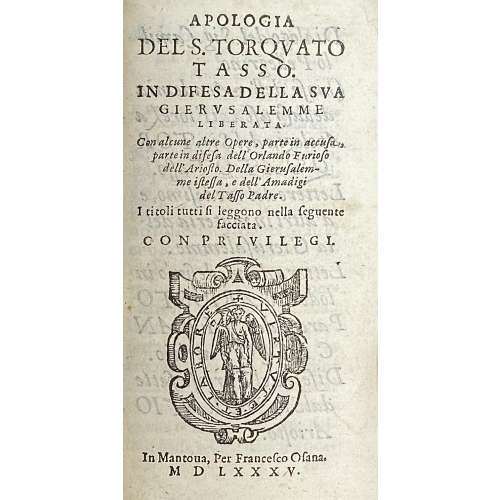 Title-page: APOLOGIA | DEL S. TORQVATO | TASSO. | IN DIFESA DELLA SVA | GIERVSALEMME | LIBERATA. | Con alcune Opere, partien in accusa, | partein difesa dell Orlando Furioso | dell’Ariosto. | Della Gierusalem- | me istessa , e dell’Amadigi | del Tasso Padre. | I titoli tutti si leggono nella feguente | facciata. | con privilegi. | {publisher’s device} | In Mantoua, Per Francesco Osana. | M D LXXXV. || 1st blank π1, [a]-a8; (9 leaves, 18 pp., unpaginated) Divisional t.p. (1): DE GLI | ACCADEMICI | DELLA CRVSCA | DIFESA DELL’ ORLANDO | FVRIOSO DELL’ ARIOSTO | Contra’l Dialogo dell’Epica | poesia di Camillo | Pellegrino. | Stacciata prima. | {woodcut} ||; A-E12 [2]A1 (61 leaves, 122 pp., unpaginated). Divisional t.p. (2): APOLOGIA | DEL S. TORQVATO | TASSO. | IN DIFESA DELLA SVA | GIERVSALEMME | LIBERATA. | {publisher’s device} | IN MANTOVA, |—| Per Francesco Osanna. | MDLXXXV. || [2]A11 2B-[2]I12 [2]K4, pp. [2] 3-219 [3] (111 leaves, 222 pages). Divisional t.p. (3): DELL’ | INFARINATO | ACADEMICO | DELLA CRVSCA … etc. | MDLXXXV. | Con licenza de’ Superiori. || [3]A-[3]G12, pp. [2] 3-164, 163 (i.e. 165) [3] (84 leaves, 168 pages). Divisional t.p. (4): RIPOSTA | DEL S. TORQVATO | TASSO, | ALLA LETTERA | DI BASTIAN ROSSI, …etc. | MDLXXXV. | Con licenza de’ Superiori. || [4]A-[4]E12 F8, ([4]B3 i.e. [4]A3), pp. [2] 3-135 [1] (68 leaves, 136 pages). Divisional t.p. (5): DISCORSO | IN TORNO | A’CONTRASTI, | CHE SI FANNO | SOPRA… ect. | M D LXXXVI. || [5]A-[5]D12 E4, pp. [2]3-67, 66 (i.e. 68), 92 (69), 70-73 (70-73), 94 (74), 95 (75), 76, 77, 98-115 (78-95), 112 (96), 97-100, [4] (52 leaves, 104 pages). Divisional t.p. (6): PARERE | DEL SIGNOR | TORQVATO | TASSO. | SOPRA IL DISCORSO | del Signor Horatio Lom- | bardello intorno a’ | contrasti,&c. … etc. | M D LXXXVI. || [6]A12 [6]B6 (incl. last blank), pp. [1-5] 6-33 [3] (18 leaves, 36 pages). Collation: 12mo; π1, a8, A-E12, [2]A-[2]I12 [2]K4, [3]A-[3]G12, [4]A-[4]E12 F8, [5]A-[5]D12 E4, [6]A12 [6]B6 (incl. last blank), total 403 leaves, 806 pages, in-text woodcut head- and tailpieces, and initials. Binding: 14.4 x 9 cm, 19th-century quarter calf over marbled boards, raised bands, gilt-bordered compartments, gilt lettering, three flyleaves at the front and back, "The Robin Collection" bookplate to front pastedown. Provenance: The Robin Collection. Contributors: Torquato Tasso (Italian, 1544 –1595) – author. Orazio Ariosto (Italian, 1555 – 1593) – author. Ludovico Ariosto (Italian, 1474 – 1533) – author. Camillo Pellegrino (Italian, 1527-1603) – author. Francesco Osanna [Osana] (Italian, fl. 1549 – 1608) – printer, publisher.
Title-page: APOLOGIA | DEL S. TORQVATO | TASSO. | IN DIFESA DELLA SVA | GIERVSALEMME | LIBERATA. | Con alcune Opere, partien in accusa, | partein difesa dell Orlando Furioso | dell’Ariosto. | Della Gierusalem- | me istessa , e dell’Amadigi | del Tasso Padre. | I titoli tutti si leggono nella feguente | facciata. | con privilegi. | {publisher’s device} | In Mantoua, Per Francesco Osana. | M D LXXXV. || 1st blank π1, [a]-a8; (9 leaves, 18 pp., unpaginated) Divisional t.p. (1): DE GLI | ACCADEMICI | DELLA CRVSCA | DIFESA DELL’ ORLANDO | FVRIOSO DELL’ ARIOSTO | Contra’l Dialogo dell’Epica | poesia di Camillo | Pellegrino. | Stacciata prima. | {woodcut} ||; A-E12 [2]A1 (61 leaves, 122 pp., unpaginated). Divisional t.p. (2): APOLOGIA | DEL S. TORQVATO | TASSO. | IN DIFESA DELLA SVA | GIERVSALEMME | LIBERATA. | {publisher’s device} | IN MANTOVA, |—| Per Francesco Osanna. | MDLXXXV. || [2]A11 2B-[2]I12 [2]K4, pp. [2] 3-219 [3] (111 leaves, 222 pages). Divisional t.p. (3): DELL’ | INFARINATO | ACADEMICO | DELLA CRVSCA … etc. | MDLXXXV. | Con licenza de’ Superiori. || [3]A-[3]G12, pp. [2] 3-164, 163 (i.e. 165) [3] (84 leaves, 168 pages). Divisional t.p. (4): RIPOSTA | DEL S. TORQVATO | TASSO, | ALLA LETTERA | DI BASTIAN ROSSI, …etc. | MDLXXXV. | Con licenza de’ Superiori. || [4]A-[4]E12 F8, ([4]B3 i.e. [4]A3), pp. [2] 3-135 [1] (68 leaves, 136 pages). Divisional t.p. (5): DISCORSO | IN TORNO | A’CONTRASTI, | CHE SI FANNO | SOPRA… ect. | M D LXXXVI. || [5]A-[5]D12 E4, pp. [2]3-67, 66 (i.e. 68), 92 (69), 70-73 (70-73), 94 (74), 95 (75), 76, 77, 98-115 (78-95), 112 (96), 97-100, [4] (52 leaves, 104 pages). Divisional t.p. (6): PARERE | DEL SIGNOR | TORQVATO | TASSO. | SOPRA IL DISCORSO | del Signor Horatio Lom- | bardello intorno a’ | contrasti,&c. … etc. | M D LXXXVI. || [6]A12 [6]B6 (incl. last blank), pp. [1-5] 6-33 [3] (18 leaves, 36 pages). Collation: 12mo; π1, a8, A-E12, [2]A-[2]I12 [2]K4, [3]A-[3]G12, [4]A-[4]E12 F8, [5]A-[5]D12 E4, [6]A12 [6]B6 (incl. last blank), total 403 leaves, 806 pages, in-text woodcut head- and tailpieces, and initials. Binding: 14.4 x 9 cm, 19th-century quarter calf over marbled boards, raised bands, gilt-bordered compartments, gilt lettering, three flyleaves at the front and back, "The Robin Collection" bookplate to front pastedown. Provenance: The Robin Collection. Contributors: Torquato Tasso (Italian, 1544 –1595) – author. Orazio Ariosto (Italian, 1555 – 1593) – author. Ludovico Ariosto (Italian, 1474 – 1533) – author. Camillo Pellegrino (Italian, 1527-1603) – author. Francesco Osanna [Osana] (Italian, fl. 1549 – 1608) – printer, publisher. -
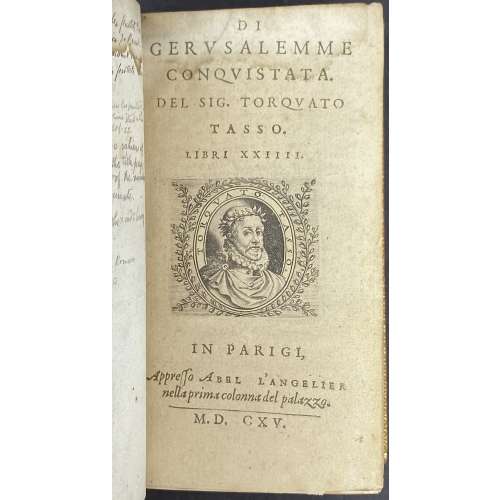 Title-page (1): DI | GERVSALEMME | CONQVISTATA. | DEL SIG. TORQVATO | TASSO. | LIBRI XXIIII. | {engraved portrait of Torquato Tasso in lettered oval medallion surrounded with laurel branches} | IN PARIGI, | Appresso Abel L’ANGELIER | nella prima Colonna del palazzo. | M.D. CXV. || Title-page (2): DI | GERVSALEMME | CONQVISTATA. | DEL SIG. TORQVATO | TASSO. | LIBRI XXIIII. | ALL’ ILL. MO ET REV. MO| SIG. RE| IL SIGNOR. | CINTHIO ALDOBRANDINI | Card. Di San Giorgio. | Appresso Abel L’ANGELIERI | nella prima Colonna del palazzo. | M.D. LCXV. || Collation: 1st blank leaf with an extensive pencil MS in French and English (unsigned), 1st t.p. / blank (unsigned), 2nd t.p. / blank [ai] (unsigned), Dedication by Angelo Ingegneri dated 10-NOV-1592 (ã2-ã5), dedication by Torquato Tasso and Aux Lecteur by Abel L’Angelier ã5[i.e. 6]-[ã9]; 12mo: π12, A-Z12, 2A-2Q12 (2Q11 woodcut / blank, 2Q12 blank), total 480 leaves, with woodcut head- and tailpieces, historiated initials. Note: leaves D6, M3, M6, and N3 unsigned; leave E2 signed for F2, E4 – for F4, Z – for Z5, and A – for Aa. Pagination: 12 prelims unpag., 1-361, each leaf paginated as one page) [2]; with a lot of mispaginations: shall be 1-468, but after p.291 follows 278 (for 292), then 193 for 293, etc. Binding: 14.5 x 8.5 cm, 20th-century tan morocco by Zaehnsdorf (signed in gilt), gilt fleurons in corners and in compartments, raised bands, titles on spine, gilt dentelles, marbled endpapers plus 6 fep at the front (one with pasted clipping “A PARIS, Chez Fetil, Libraire, rue des Cor-| deliers, près celle de Condé, au | Parnasse Italien”, and 2 at the end. What connection has the 18th-century publisher with this edition remains unclear. “The Robin Collection” bookplate to front pastedown. Edges sprinkled red. Occasional damp staining to top margins. There is controversy regarding the year of this publication. It could be 1615 (MDCXV), however, both the publisher and the dedicatee were dead this year. Dedication by the publisher dated 1592. We agree with those scholars who suggest that MDCXV and MDLCXV were misprinted for MDXCV (1595). Provenance: The Robin Collection. Contributors: Torquato Tasso (Italian, 1544 –1595) – author. Angelo Ingegneri (Italian, 1550 – 1613) – author. Abel L'Angelier (French, 1553? – 1610) – printer, publisher. Cinzio Aldobrandini (Italian, 1551 – 1610) – dedicatee.
Title-page (1): DI | GERVSALEMME | CONQVISTATA. | DEL SIG. TORQVATO | TASSO. | LIBRI XXIIII. | {engraved portrait of Torquato Tasso in lettered oval medallion surrounded with laurel branches} | IN PARIGI, | Appresso Abel L’ANGELIER | nella prima Colonna del palazzo. | M.D. CXV. || Title-page (2): DI | GERVSALEMME | CONQVISTATA. | DEL SIG. TORQVATO | TASSO. | LIBRI XXIIII. | ALL’ ILL. MO ET REV. MO| SIG. RE| IL SIGNOR. | CINTHIO ALDOBRANDINI | Card. Di San Giorgio. | Appresso Abel L’ANGELIERI | nella prima Colonna del palazzo. | M.D. LCXV. || Collation: 1st blank leaf with an extensive pencil MS in French and English (unsigned), 1st t.p. / blank (unsigned), 2nd t.p. / blank [ai] (unsigned), Dedication by Angelo Ingegneri dated 10-NOV-1592 (ã2-ã5), dedication by Torquato Tasso and Aux Lecteur by Abel L’Angelier ã5[i.e. 6]-[ã9]; 12mo: π12, A-Z12, 2A-2Q12 (2Q11 woodcut / blank, 2Q12 blank), total 480 leaves, with woodcut head- and tailpieces, historiated initials. Note: leaves D6, M3, M6, and N3 unsigned; leave E2 signed for F2, E4 – for F4, Z – for Z5, and A – for Aa. Pagination: 12 prelims unpag., 1-361, each leaf paginated as one page) [2]; with a lot of mispaginations: shall be 1-468, but after p.291 follows 278 (for 292), then 193 for 293, etc. Binding: 14.5 x 8.5 cm, 20th-century tan morocco by Zaehnsdorf (signed in gilt), gilt fleurons in corners and in compartments, raised bands, titles on spine, gilt dentelles, marbled endpapers plus 6 fep at the front (one with pasted clipping “A PARIS, Chez Fetil, Libraire, rue des Cor-| deliers, près celle de Condé, au | Parnasse Italien”, and 2 at the end. What connection has the 18th-century publisher with this edition remains unclear. “The Robin Collection” bookplate to front pastedown. Edges sprinkled red. Occasional damp staining to top margins. There is controversy regarding the year of this publication. It could be 1615 (MDCXV), however, both the publisher and the dedicatee were dead this year. Dedication by the publisher dated 1592. We agree with those scholars who suggest that MDCXV and MDLCXV were misprinted for MDXCV (1595). Provenance: The Robin Collection. Contributors: Torquato Tasso (Italian, 1544 –1595) – author. Angelo Ingegneri (Italian, 1550 – 1613) – author. Abel L'Angelier (French, 1553? – 1610) – printer, publisher. Cinzio Aldobrandini (Italian, 1551 – 1610) – dedicatee. -
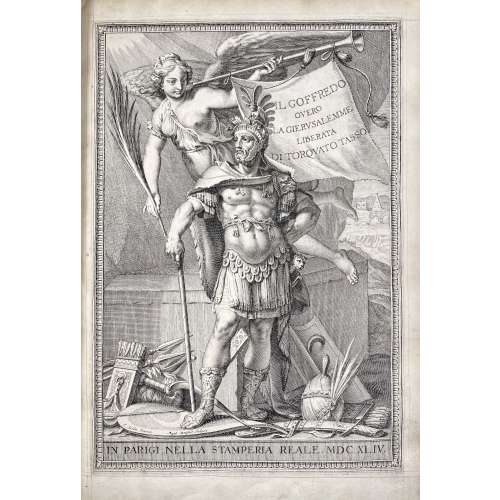 Title page: IL | GOFFREDO | OVERO | LA | GIERUSALEMME | LIBERATA | DI TORQUATO TASSO. || Engraved title: On the banner: IL GOFFREDO | OVERO | LA GIERUSALEMME | LIBERATA | DI TORQUATO TASSO ||; under the image, within frame: IN PARIGI NELLA STAMPERIA REALE MDC XLIV. Signed: J. Stella Invenit — Ægid Rousselet Sculpsit (with tall “s”) || Collation: 2 blank leaves with donation ink inscription to recto of the 1st: “Ex Dono Patruelis Do Roberto Willughby” [i.e. Robert Willoughby]; t.p. / blank, engraved t.p. by Gilles Rousselet after Jacques Stella / blank, “Allegoria dell poema” 4 leaves, 1st two leaves signed iij and iiij, respectively; π6 A-Z4 Aa-Zz4 Aaa-Rrr4, 2 blank leaves at the end; text paginated from 1 to 502 [2] (p. 503 tailpiece, p. 504 blank); a printable area marked with vertical and horizontal double lines; total: 252 leaves of text (504 pages), 6 prelims and 4 blanks. Illustrated throughout with head- and tailpieces, and historiated initials. Binding: 18th-century red crushed morocco, triple-fillet gilt border, triple-fillet gilt frame, panel with gilt lozenge centrepiece, lozenges at corners, marbled endpapers, AEG, crudely rebacked retaining original spine with raised bands, gilt in compartments, crimson label with gilt lettering; The Robin Collection bookplate to front pastedown. Provenance: The Robin Collection; Robert Willoughby family. Contributors: Torquato Tasso (Italian, 1544 –1595) – author. Jacques Stella (French, 1596 – 1657) – artist. Gilles [Aegidius] Rousselet (French, 1610 – 1686) – engraver.
Title page: IL | GOFFREDO | OVERO | LA | GIERUSALEMME | LIBERATA | DI TORQUATO TASSO. || Engraved title: On the banner: IL GOFFREDO | OVERO | LA GIERUSALEMME | LIBERATA | DI TORQUATO TASSO ||; under the image, within frame: IN PARIGI NELLA STAMPERIA REALE MDC XLIV. Signed: J. Stella Invenit — Ægid Rousselet Sculpsit (with tall “s”) || Collation: 2 blank leaves with donation ink inscription to recto of the 1st: “Ex Dono Patruelis Do Roberto Willughby” [i.e. Robert Willoughby]; t.p. / blank, engraved t.p. by Gilles Rousselet after Jacques Stella / blank, “Allegoria dell poema” 4 leaves, 1st two leaves signed iij and iiij, respectively; π6 A-Z4 Aa-Zz4 Aaa-Rrr4, 2 blank leaves at the end; text paginated from 1 to 502 [2] (p. 503 tailpiece, p. 504 blank); a printable area marked with vertical and horizontal double lines; total: 252 leaves of text (504 pages), 6 prelims and 4 blanks. Illustrated throughout with head- and tailpieces, and historiated initials. Binding: 18th-century red crushed morocco, triple-fillet gilt border, triple-fillet gilt frame, panel with gilt lozenge centrepiece, lozenges at corners, marbled endpapers, AEG, crudely rebacked retaining original spine with raised bands, gilt in compartments, crimson label with gilt lettering; The Robin Collection bookplate to front pastedown. Provenance: The Robin Collection; Robert Willoughby family. Contributors: Torquato Tasso (Italian, 1544 –1595) – author. Jacques Stella (French, 1596 – 1657) – artist. Gilles [Aegidius] Rousselet (French, 1610 – 1686) – engraver. -
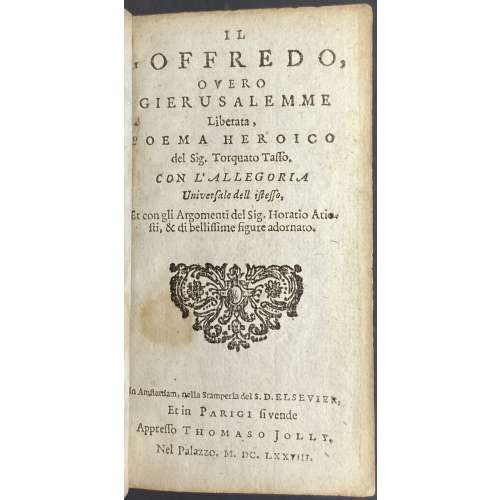 Vol. 1: Engraved t.p.: An architectural setting with flags and arms, and sitting male and female figures in armour, perhaps representing Tancredi and Clorinda, with lettering above their heads: “GIERVSA– | LEMME | LIBERATA”. Title-page: IL | GOFFREDO, | OVERO | GIERUSALEMME | Liberata , | POEMA HEROICO | del Sig. Torquato Tasso. | CON L’ ALLEGORIA | Universale dell istesso, | Et con gli Argomenti del Sig. Horatio Ario- | sti, & di belissime figure adornato. | {woodcut element} | In Amsterdam, nella Stamperia del S.D. ELZEVIER, | Et in Parigi, si vende | Appresso Thomaso Jolly. | Nel Palazzo, M. DC. LXXVIII. || Collation: 8vo; [A1] 1st blank, engraved t.p., [A2] letterpress t.p., pp. [1-4]; signatures start at A3, pagination starts at p. 37; Allegoria: A3-B1, pp. [5-18], Tavola: B2-C2, pp. [19-36]; Il Goffredo: C3-R8, pp. 37-271 [272]. Total A-R8: 136 leaves (272 pages), plus 11 plates, incl. engraved t.p., and frontispiece (sculptural bust portrait of Torquato Tasso in a laurel wreath, with a lettered plate below “TORQVATO | TASSO”). Vol. 1: Title-page: Similar but “TOMO II.” after “sti, & di belissime figure adornato.” and before the woodcut element. Collation: 8vo; 1st blank, letterpress t.p., signatures start at A3, p. 5; A-S8, pp. [4] 5-285 [3]. Total A-S8: 144 leaves (288 pages) plus 10 engraved plates. Binding: Two volumes 15 x 6 cm, uniformly bound in 19th-century green morocco, gilt triple-fillet border, bull heads at corners, spine with raised bands, gilt in compartments, two gilt-lettered crimson labels, blue endpapers, 2 blank laid paper leaves in the front, AEG. Contributors: Torquato Tasso (Italian, 1544 –1595) – author. Daniel Elzevir (Dutch, 1626-1680) – publisher. Thomas Jolly (French, fl. 1648 – 1694) – publisher.
Vol. 1: Engraved t.p.: An architectural setting with flags and arms, and sitting male and female figures in armour, perhaps representing Tancredi and Clorinda, with lettering above their heads: “GIERVSA– | LEMME | LIBERATA”. Title-page: IL | GOFFREDO, | OVERO | GIERUSALEMME | Liberata , | POEMA HEROICO | del Sig. Torquato Tasso. | CON L’ ALLEGORIA | Universale dell istesso, | Et con gli Argomenti del Sig. Horatio Ario- | sti, & di belissime figure adornato. | {woodcut element} | In Amsterdam, nella Stamperia del S.D. ELZEVIER, | Et in Parigi, si vende | Appresso Thomaso Jolly. | Nel Palazzo, M. DC. LXXVIII. || Collation: 8vo; [A1] 1st blank, engraved t.p., [A2] letterpress t.p., pp. [1-4]; signatures start at A3, pagination starts at p. 37; Allegoria: A3-B1, pp. [5-18], Tavola: B2-C2, pp. [19-36]; Il Goffredo: C3-R8, pp. 37-271 [272]. Total A-R8: 136 leaves (272 pages), plus 11 plates, incl. engraved t.p., and frontispiece (sculptural bust portrait of Torquato Tasso in a laurel wreath, with a lettered plate below “TORQVATO | TASSO”). Vol. 1: Title-page: Similar but “TOMO II.” after “sti, & di belissime figure adornato.” and before the woodcut element. Collation: 8vo; 1st blank, letterpress t.p., signatures start at A3, p. 5; A-S8, pp. [4] 5-285 [3]. Total A-S8: 144 leaves (288 pages) plus 10 engraved plates. Binding: Two volumes 15 x 6 cm, uniformly bound in 19th-century green morocco, gilt triple-fillet border, bull heads at corners, spine with raised bands, gilt in compartments, two gilt-lettered crimson labels, blue endpapers, 2 blank laid paper leaves in the front, AEG. Contributors: Torquato Tasso (Italian, 1544 –1595) – author. Daniel Elzevir (Dutch, 1626-1680) – publisher. Thomas Jolly (French, fl. 1648 – 1694) – publisher. -
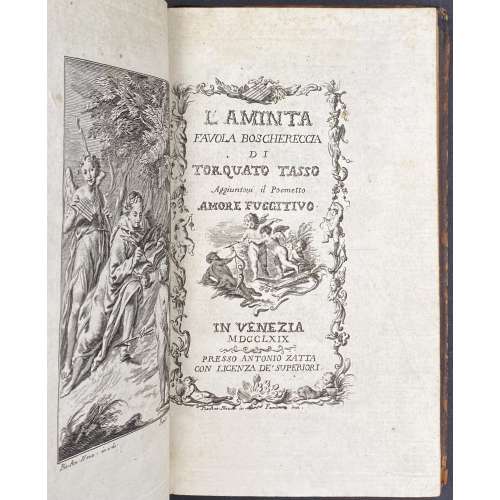 Engraved title-page: L'AMINTA | FAVOLA BOSCHERECCIA | DI | TORQUATO TASSO | Aggiuntovi il Poemetto | Amore Fugitivo |{vignette} | IN VENEZIA | MDCCLXIX |—| PRESSO ANTONIO ZATTA | CON LICENZA DE’ SUPERIORI || in historiated frame, signed below: “Pet. Ant. Novelli in — Fambrini inci.” Pagination: [i] ii-xxiv, [1-2] 3-84, total 108 pages, ils. Collation: 12mo; a12, A-C12 D6, last blank; first 6 leaves signed in 12-leave quires, first 3 in D; total 54 leaves plus 9 plates, incl. engraved title and frontispiece, and numerous head- and tailpieces by Fambrini after Novelli. Binding: 18.6 x 11 cm, contemporary tree calf, rebacked, crimson label with gilt lettering; clipping and bookplate of The Robin Collection to front pastedown; verso front flyleaf stamped “RESTORED BY MACDONALD CO. | NORWALK. CONN.” Additional blank leaves at front and back. Provenance: Satinsky, Robin F. (American, 1919 – 2008); The Robin Collection. Contributors: Torquato Tasso (Italian, 1544 –1595) – author. Pietro Antonio Novelli (Italian, 1729 – 1804) – artist. Ferdinando Fambrini (Italian (1764 – c.1793) – engraver. Antonio Zatta (Italian, c. 1722 – 1804) – printer, publisher.
Engraved title-page: L'AMINTA | FAVOLA BOSCHERECCIA | DI | TORQUATO TASSO | Aggiuntovi il Poemetto | Amore Fugitivo |{vignette} | IN VENEZIA | MDCCLXIX |—| PRESSO ANTONIO ZATTA | CON LICENZA DE’ SUPERIORI || in historiated frame, signed below: “Pet. Ant. Novelli in — Fambrini inci.” Pagination: [i] ii-xxiv, [1-2] 3-84, total 108 pages, ils. Collation: 12mo; a12, A-C12 D6, last blank; first 6 leaves signed in 12-leave quires, first 3 in D; total 54 leaves plus 9 plates, incl. engraved title and frontispiece, and numerous head- and tailpieces by Fambrini after Novelli. Binding: 18.6 x 11 cm, contemporary tree calf, rebacked, crimson label with gilt lettering; clipping and bookplate of The Robin Collection to front pastedown; verso front flyleaf stamped “RESTORED BY MACDONALD CO. | NORWALK. CONN.” Additional blank leaves at front and back. Provenance: Satinsky, Robin F. (American, 1919 – 2008); The Robin Collection. Contributors: Torquato Tasso (Italian, 1544 –1595) – author. Pietro Antonio Novelli (Italian, 1729 – 1804) – artist. Ferdinando Fambrini (Italian (1764 – c.1793) – engraver. Antonio Zatta (Italian, c. 1722 – 1804) – printer, publisher. -
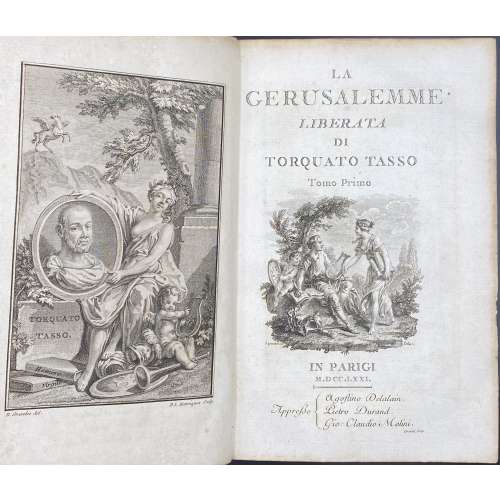 A two-volume set. Vol. 1:
A two-volume set. Vol. 1:Title: LA | GERUSALEMME | LIBERATA | DI | TORQUATO TASSO | Tomo Primo | {vignette} | IN PARIGI | M.DCC.LXXI | Appreßo { Agostino Delalain. | Pietro Durand. | Gio: Claudio Molini. | Droüet ∫crip.
Pagination: ffl [1] 2-331 [332] bfl; illustrations after Gravelot: frontis. by Henriquez, t.p. vignette by Patas, engraved dedication by Le Roy, 10 head- and 7 tailpieces by Le Roy, 5 full-page vignettes by Le Roy, and 10 plates by: Baquoy, Duclos (3), Le Roy, Lingée, Née, Rousseau, and Simonet (2).
Collation: 8vo; A-V8 X6.
Vol. 2: Title: LA | GERUSALEMME | LIBERATA | DI | TORQUATO TASSO | Tomo Secondo | {vignette} | IN PARIGI | M.DCC.LXXI | Appreßo { Agostino Delalain. | Pietro Durand. | Gio: Claudio Molini. | Droüet ∫crip. Pagination: ffl [1] 2-340 bfl; illustrations after Gravelot: frontis. by Henriquez, t.p. vignette by Mesnil, 10 head- and 6 tailpieces by Le Roy, 4 full-page vignettes by Le Roy, tailpiece by Ponce, and 10 plates by: Duclos, Henriquez, Leveau, Lingée, Massard, Née, Patas, Ponce, Rousseau, and Simonet. Collation: 8vo; A-X8 Y2. Size: 21.5 x 14.5 cm. Size of the copy sold at Sotheby's in 2015: 23.3 x 14.0 cm; Christie's in 2008: 23.2 x 14.4 cm Page size: 21 x 13.5 cm. In referenced sources, the page size is bigger than that. N. Ray gives 11 ½ x 8 7⁄8 inches or 9 x 5½ inches. Cohen and De Ricci do not bother to give sizes, considering that octavo is octavo. MFA: 30.3 x 23.1 x 4 cm (11 15/16 x 9 1/8 x 1 9/16 in.) Binding: Two volumes uniformly bound in full marbled calf, ruled in gilt, flat spine with gilt decorations and monogram, cream lettered label. Geoffrey Lord Cross of Chelsea [Geoffrey Cross, Baron Cross of Chelsea] (British, 1904 – 1989) bookplate to front pastedown. Catalogue raisonné: N. Ray №22, p. 48; Cohen De Ricci 974-975 According to MFA printing by: François-Augustin Quillau (French, 1743–1804). This edition was illustrated by Hubert François Gravelot (French, 1699–1773) and engraved by the following engravers: Jean Charles Baquoy (French, 1721–1777) Antoine Jean Duclos (French, 1742–1795) Benoît Louis Henriquez (French, 1732–1806) Jean Jacques André Le Veau (French, 1729–1785) Charles Louis Lingée (French, 1748–1819) Jacques Le Roy (French, born in 1739) Jean Massard (1740–1822) Elie du Mesnil (French, born about 1728) François Denis Née (French, 1735–1818) Charles Emmanuel Jean Baptiste Patas (French, 1744–1802) Nicholas Ponce (French, 1746–1831) Jean François Rousseau (French, born in 1740) Jean Baptiste Simonet (French, 1742–1813) Droüet (French, 18th century) -
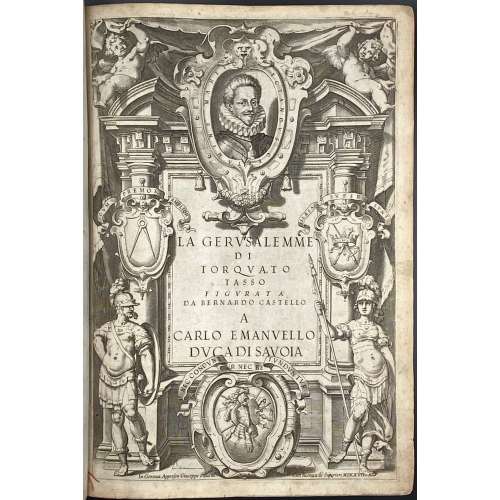 Engraved title-page 1, as per British Museum: An architectural setting with, at upper centre, a portrait of Carlo Emanuele I, Duke of Savoy, in an ornate cartouche lettered “"Spectandus Certamine Martio"; a central title “LA | GERUSALEMME | DI | TORQUATO | TASSO | FUGURATA A | DA BERNARDO CASTELLO | A | CARLO EMANUELLO | DVCA DI SAVOIA” flanked by Tuscan columns and crests with mottos and imprese showing compasses lettered "Dvm Premor Amplior", at left, and a crossed sword and sceptre with a crown lettered "Illaesa Super Sunt", at right; in the lower register, male and female figures in armour, perhaps representing Tancredi and Clorinda, with a central crest showing an impresa of armour”. Central title: Below, within frame: "In Genova, Appresso Giuseppe Pavoni. […] Con licenza de' Superiori. MDCXVII." Engraved title-page 2, as per British Museum: Portrait of Torquato Tasso, bust, facing front, wearing a laurel crown; within an oval pendant, lettered “TOROVATO […] TASSO EF”, suspended from a pediment, beneath which a view of Genoa is flanked by two columns, and above is a tablet, lettered: “LA GERUSALEMME | LIBERATA | DI TORQUATO | TASSO. | Con le annotazioni | di Scipion | Gentili, e di Givlio | Guastauini , | Et li argomenti di Oratio Ariosti , | STAMPATA | Per Giuseppe Pauoni ad instanza di | Bernardo Castello,in Genova | L’Anno MDCXVII." Collation: 8vo; 2 leaves of engraved title-pages, 1 leaf signed †2, 1 leaf unsigned, 2 leaves signed †† and ††2, respectively, 1 leaf unsigned, 1 leaf with engraving to verso (frontispiece to Canto Primo) —> 8 prelims (besides FEP or a blank leaf before 1st t.p.); π8 A-Q8 (pp. 1-255 [256 blank], plated within collation), G1, I1, K1, O1, and P1 (recto to plates without text) unsigned, L3 signed as second L2; A-D8 E4 (pp. 1-71 [72]; A-B8 C4 χ1 (pp. [1] 2-36 [37-40] [2]), in the 4-leaf quires E and C only two first leaves signed, in the 8-leaf quires four first leaves signed. Illustrations: woodcut head- and tail-pieces, woodcut initials, some historiated, and 20 plates within collation and pagination engraved by Camillo Cungio after Bernardo Castello. Binding: 30.5 x 21.4 cm overall, 30 x 20.5 cm leaves; contemporary vellum, rebacked with modern brown morocco, crimson morocco label with gilt lettering and double-fillet outline. Two bookplates to front pastedown: (1) Chippendale armorial bookplate (8.3 x 7.6 cm): Thos. Brand Esqr. Signed: W Austin — Fecit; (2) The Robin Collection bookplate. Bookseller’s ticket to back pastedown: “J. POOLE. | British & foreign | BOOKSELLER, | 39 BOOKSELLERS ROW, | STRAND |〰️| Books Bought.” All edges green. Provenance: The Robin Collection; Thomas Brand Hollis (British, 1719 – 1804). Contributors: Torquato Tasso (Italian, 1544 –1595) – author. Scipione Gentili [Scipio Gentilis] (Italian, 1563 – 1616) – author. Giulio Guastavini (Italian, fl. 16th century) – author. Bernardo Castello [Castelli] (Italian, 1557 – 1629) – artist. Camillo Cungi (Italian, fl. 1597 – 1649) – engraver. Giuseppe Pavoni (Italian, 1551 – c. 1641) – printer, publisher. Carlo Emanuele I, Duke of Savoy (Italian, 1562 – 1630) – dedicatee.
Engraved title-page 1, as per British Museum: An architectural setting with, at upper centre, a portrait of Carlo Emanuele I, Duke of Savoy, in an ornate cartouche lettered “"Spectandus Certamine Martio"; a central title “LA | GERUSALEMME | DI | TORQUATO | TASSO | FUGURATA A | DA BERNARDO CASTELLO | A | CARLO EMANUELLO | DVCA DI SAVOIA” flanked by Tuscan columns and crests with mottos and imprese showing compasses lettered "Dvm Premor Amplior", at left, and a crossed sword and sceptre with a crown lettered "Illaesa Super Sunt", at right; in the lower register, male and female figures in armour, perhaps representing Tancredi and Clorinda, with a central crest showing an impresa of armour”. Central title: Below, within frame: "In Genova, Appresso Giuseppe Pavoni. […] Con licenza de' Superiori. MDCXVII." Engraved title-page 2, as per British Museum: Portrait of Torquato Tasso, bust, facing front, wearing a laurel crown; within an oval pendant, lettered “TOROVATO […] TASSO EF”, suspended from a pediment, beneath which a view of Genoa is flanked by two columns, and above is a tablet, lettered: “LA GERUSALEMME | LIBERATA | DI TORQUATO | TASSO. | Con le annotazioni | di Scipion | Gentili, e di Givlio | Guastauini , | Et li argomenti di Oratio Ariosti , | STAMPATA | Per Giuseppe Pauoni ad instanza di | Bernardo Castello,in Genova | L’Anno MDCXVII." Collation: 8vo; 2 leaves of engraved title-pages, 1 leaf signed †2, 1 leaf unsigned, 2 leaves signed †† and ††2, respectively, 1 leaf unsigned, 1 leaf with engraving to verso (frontispiece to Canto Primo) —> 8 prelims (besides FEP or a blank leaf before 1st t.p.); π8 A-Q8 (pp. 1-255 [256 blank], plated within collation), G1, I1, K1, O1, and P1 (recto to plates without text) unsigned, L3 signed as second L2; A-D8 E4 (pp. 1-71 [72]; A-B8 C4 χ1 (pp. [1] 2-36 [37-40] [2]), in the 4-leaf quires E and C only two first leaves signed, in the 8-leaf quires four first leaves signed. Illustrations: woodcut head- and tail-pieces, woodcut initials, some historiated, and 20 plates within collation and pagination engraved by Camillo Cungio after Bernardo Castello. Binding: 30.5 x 21.4 cm overall, 30 x 20.5 cm leaves; contemporary vellum, rebacked with modern brown morocco, crimson morocco label with gilt lettering and double-fillet outline. Two bookplates to front pastedown: (1) Chippendale armorial bookplate (8.3 x 7.6 cm): Thos. Brand Esqr. Signed: W Austin — Fecit; (2) The Robin Collection bookplate. Bookseller’s ticket to back pastedown: “J. POOLE. | British & foreign | BOOKSELLER, | 39 BOOKSELLERS ROW, | STRAND |〰️| Books Bought.” All edges green. Provenance: The Robin Collection; Thomas Brand Hollis (British, 1719 – 1804). Contributors: Torquato Tasso (Italian, 1544 –1595) – author. Scipione Gentili [Scipio Gentilis] (Italian, 1563 – 1616) – author. Giulio Guastavini (Italian, fl. 16th century) – author. Bernardo Castello [Castelli] (Italian, 1557 – 1629) – artist. Camillo Cungi (Italian, fl. 1597 – 1649) – engraver. Giuseppe Pavoni (Italian, 1551 – c. 1641) – printer, publisher. Carlo Emanuele I, Duke of Savoy (Italian, 1562 – 1630) – dedicatee. -
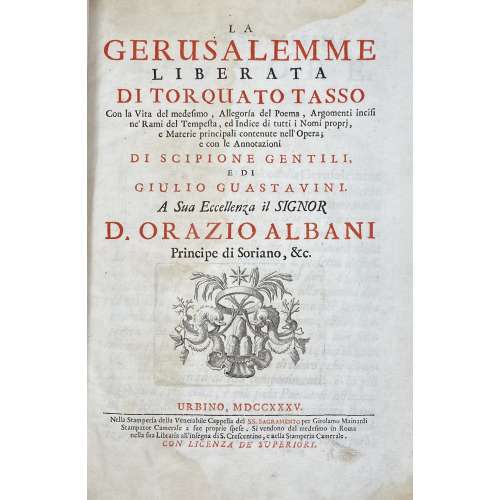 Title page (in red and black): LA | GERUSALEMME | LIBERATA | DI TORQUATO TASSO | Con la Vita del medesimo , Allegoria del Poema , Argomenti incisi | ne’Rami del Tempesta , ed Indice di tutti i Nomi proprj , | e Materie principali contenute nell’Opera ; | e con le Annotazioni | DI SCIPIONE GENTILI | E DI | GIULIO GUASTAVINI. | A Sua Eccellenza il SIGNOR | D. ORAZIO ALBANI | Principe di Soriano, &c. | {printer’s device} | URBINO, MDCCXXXV. | — | Nella Stamperia della Venerabile Cappella del SS. SAGRAMENTO per Girolamo Mainardi | Stampator Camerale a sue proprie spese . Si vendono dal medesimo in Roma | nella sua Libraria all’insegna di S. Crescentino, e nella Stamperia Camerale | CON LICENZA DE SUPERIORI. || Half-title: Title page: IL | GOFFREDO | OVVERO | LA GERUSALEMME | LIBERATA | DI | TORQUATO TASSO. || Collation: 4to; [2] blank leaves, [1] – h.t. / blank, [1] – t.p. / blank, [1] – dedication signed *2, [2] – vita, 1st signed *3, [2] – allegoria, [3] – indice, first two signed ** and **2, respectively, [1] – frontispiece to Canto Primo —> total 13 prelims; π13 (incl. 2 blanks), A-Z4 Aa-Bb4 Cc6 Dd-Qq4, χ1 (blank); 20 engraved frontispieces, one headpiece and initials, some historiated. Frontis. to Cantos II-XX incl. in collation and pagination; the number of leaves from A1 to Qq4 = 158; pagination: 1-316. The total number of leaves incl. prelims and blanks = 172. Note: three first leaves in the Cc quire of six leaves are signed; all other four-leaf quires only have the first two first leaves signed. Frontispiece to Canto Quarto cut down and laid down on D2v (as in Christie’s copy sold on 6 Jun 2010 – Live Auction 5475 – Fine Printed Books and Manuscripts, lot 168, price realized GBP 600). Illustrations: Frontispiece to Canto Primo signed “Arnoldo van Westerhout formis Roma”. Headpiece to Canto Primo signed “Eq. Petrus Leo Ghezius Inu. et. delin. — Frãn. Aquila incid.” Other plates unsigned but all attributed to Westerhout after Antonio Tempesta; Numeration of frontispieces in roman numbers, IIII for VI, VIIII for IX, XIIII for XIV, inverted numbers XVII, XVIII, and XIX, respectively: IIVX, IIIVX, and IIIIVX. Binding: 35 x 24 cm, 34 x 23 cm leaves, contemporary calf, rebacked retaining original spine, verso front flyleaf stamped “RESTORED BY MACDONALD CO. | NORWALK. CONN. Marbled endpapers, all edges red. Speckled calf, gilt triple-fillet borders, with remnants of blind-stamped and gilt design to an upper inside corner, spine with raised bands, gilt acorn tooling in compartments, later crimson label with gilt lettering. Damp staining to inside edges affecting all leaves. The Robin Collection bookplate to front pastedown. Provenance: The Robin Collection. Contributors: Torquato Tasso (Italian, 1544 –1595) – author. Scipione Gentili [Scipio Gentilis] (Italian, 1563 – 1616) Giulio Guastavini (Italian, fl. 16th century) Antonio Tempesta [Tempestino] (Italian, 1555 – 1630) – artist. Arnold [Arnoldo] van Westerhout (Flemish, 1651 – 1725) – artist, engraver. Pier Leone Ghezzi (Italian, 1674 – 1755) – artist. Francesco Faraone Aquila (Italian, c. 1676 – c. 1740) – engraver. Girolamo Mainardi (Italian, c. 1679 circa – 1763) – printer, publisher. Orazio Albani (Italian, 1576 – 1653) – dedicatee.
Title page (in red and black): LA | GERUSALEMME | LIBERATA | DI TORQUATO TASSO | Con la Vita del medesimo , Allegoria del Poema , Argomenti incisi | ne’Rami del Tempesta , ed Indice di tutti i Nomi proprj , | e Materie principali contenute nell’Opera ; | e con le Annotazioni | DI SCIPIONE GENTILI | E DI | GIULIO GUASTAVINI. | A Sua Eccellenza il SIGNOR | D. ORAZIO ALBANI | Principe di Soriano, &c. | {printer’s device} | URBINO, MDCCXXXV. | — | Nella Stamperia della Venerabile Cappella del SS. SAGRAMENTO per Girolamo Mainardi | Stampator Camerale a sue proprie spese . Si vendono dal medesimo in Roma | nella sua Libraria all’insegna di S. Crescentino, e nella Stamperia Camerale | CON LICENZA DE SUPERIORI. || Half-title: Title page: IL | GOFFREDO | OVVERO | LA GERUSALEMME | LIBERATA | DI | TORQUATO TASSO. || Collation: 4to; [2] blank leaves, [1] – h.t. / blank, [1] – t.p. / blank, [1] – dedication signed *2, [2] – vita, 1st signed *3, [2] – allegoria, [3] – indice, first two signed ** and **2, respectively, [1] – frontispiece to Canto Primo —> total 13 prelims; π13 (incl. 2 blanks), A-Z4 Aa-Bb4 Cc6 Dd-Qq4, χ1 (blank); 20 engraved frontispieces, one headpiece and initials, some historiated. Frontis. to Cantos II-XX incl. in collation and pagination; the number of leaves from A1 to Qq4 = 158; pagination: 1-316. The total number of leaves incl. prelims and blanks = 172. Note: three first leaves in the Cc quire of six leaves are signed; all other four-leaf quires only have the first two first leaves signed. Frontispiece to Canto Quarto cut down and laid down on D2v (as in Christie’s copy sold on 6 Jun 2010 – Live Auction 5475 – Fine Printed Books and Manuscripts, lot 168, price realized GBP 600). Illustrations: Frontispiece to Canto Primo signed “Arnoldo van Westerhout formis Roma”. Headpiece to Canto Primo signed “Eq. Petrus Leo Ghezius Inu. et. delin. — Frãn. Aquila incid.” Other plates unsigned but all attributed to Westerhout after Antonio Tempesta; Numeration of frontispieces in roman numbers, IIII for VI, VIIII for IX, XIIII for XIV, inverted numbers XVII, XVIII, and XIX, respectively: IIVX, IIIVX, and IIIIVX. Binding: 35 x 24 cm, 34 x 23 cm leaves, contemporary calf, rebacked retaining original spine, verso front flyleaf stamped “RESTORED BY MACDONALD CO. | NORWALK. CONN. Marbled endpapers, all edges red. Speckled calf, gilt triple-fillet borders, with remnants of blind-stamped and gilt design to an upper inside corner, spine with raised bands, gilt acorn tooling in compartments, later crimson label with gilt lettering. Damp staining to inside edges affecting all leaves. The Robin Collection bookplate to front pastedown. Provenance: The Robin Collection. Contributors: Torquato Tasso (Italian, 1544 –1595) – author. Scipione Gentili [Scipio Gentilis] (Italian, 1563 – 1616) Giulio Guastavini (Italian, fl. 16th century) Antonio Tempesta [Tempestino] (Italian, 1555 – 1630) – artist. Arnold [Arnoldo] van Westerhout (Flemish, 1651 – 1725) – artist, engraver. Pier Leone Ghezzi (Italian, 1674 – 1755) – artist. Francesco Faraone Aquila (Italian, c. 1676 – c. 1740) – engraver. Girolamo Mainardi (Italian, c. 1679 circa – 1763) – printer, publisher. Orazio Albani (Italian, 1576 – 1653) – dedicatee. -
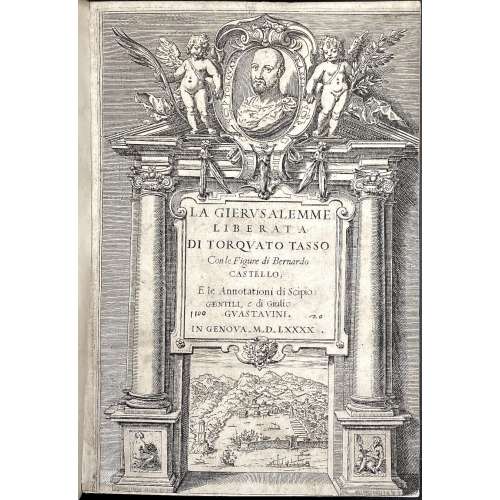 Engraved title with the portrait of Torquato Tasso, displayed in an oval medallion, bound in “TORQUATO TASSO”, between two naked putti; Architecture with two columns and Ionic capitals supporting an architectural pediment; between the columns is a table with the inscription: LA GIERVSALEMME | LIBERATA | DI TORQVATO TASSO | Con le Figure di Bernardo | CASTELLO; | E le Annotazioni di Scipio | GENTILI, e di Giulio | GVASTAVINI. | IN GENOVA. M.D.LXXXX .|| Contents: The 20 cantos are followed by: Tutte le stanza intere, che dall'autore sono state refiutate in questo libro; Annotationi di Scipio Gentili; Luoghi osservati dal mag. Giulio Guastavini, quali il Tasso nella sua Gierusalemme hà presi & imitati da poeti & altri scrittori antichi; Allegoria del poema; Tavola di tutti i nomi proprii et di tutte le materie principali contenute nel presente libro. Pagination: [2] engraved t.p. / blank, 3-11, [1] 2-255 [256], 1-71 [72] [1] 2-40, 4 unpag. leaves ‘Allegoria del poema’; total 387 pp. Collation: 8vo; π6 A-Q8 A-D8 E4 A-B8 χ4 (in the first quire M4 marked L4), ills. signed in collation. At p. 17 canto 3rd marked as 2nd, pp. 135 and 139 in 12th canto marked as 11th. Binding: later full polished calf, blind double-ruled covers, blind double-ruled raised bands, gilt lettering: GIERVSALEMME | LIBERATA and GENOVA | 1590. TMG. Printed on laid paper. Front joints split at head and tail. Title page and twenty full-page ill. facing the opening of each canto, engraved by Agostino Carracci and Giacomo Franco after Castello. Those for cantos 6-8, 10, 12, 16-17, 19-20 are by Carracci, 8 and 19 with his initials. The remainder are by Franco and are signed by him. Woodcut head and tailpieces, the Argomenti at the head of each canto within cartouches, initials. Catalogue raisonné: Adam Bartsch. Le peintre graveur. — Vienne: J. V. Degen, 1803.
Engraved title with the portrait of Torquato Tasso, displayed in an oval medallion, bound in “TORQUATO TASSO”, between two naked putti; Architecture with two columns and Ionic capitals supporting an architectural pediment; between the columns is a table with the inscription: LA GIERVSALEMME | LIBERATA | DI TORQVATO TASSO | Con le Figure di Bernardo | CASTELLO; | E le Annotazioni di Scipio | GENTILI, e di Giulio | GVASTAVINI. | IN GENOVA. M.D.LXXXX .|| Contents: The 20 cantos are followed by: Tutte le stanza intere, che dall'autore sono state refiutate in questo libro; Annotationi di Scipio Gentili; Luoghi osservati dal mag. Giulio Guastavini, quali il Tasso nella sua Gierusalemme hà presi & imitati da poeti & altri scrittori antichi; Allegoria del poema; Tavola di tutti i nomi proprii et di tutte le materie principali contenute nel presente libro. Pagination: [2] engraved t.p. / blank, 3-11, [1] 2-255 [256], 1-71 [72] [1] 2-40, 4 unpag. leaves ‘Allegoria del poema’; total 387 pp. Collation: 8vo; π6 A-Q8 A-D8 E4 A-B8 χ4 (in the first quire M4 marked L4), ills. signed in collation. At p. 17 canto 3rd marked as 2nd, pp. 135 and 139 in 12th canto marked as 11th. Binding: later full polished calf, blind double-ruled covers, blind double-ruled raised bands, gilt lettering: GIERVSALEMME | LIBERATA and GENOVA | 1590. TMG. Printed on laid paper. Front joints split at head and tail. Title page and twenty full-page ill. facing the opening of each canto, engraved by Agostino Carracci and Giacomo Franco after Castello. Those for cantos 6-8, 10, 12, 16-17, 19-20 are by Carracci, 8 and 19 with his initials. The remainder are by Franco and are signed by him. Woodcut head and tailpieces, the Argomenti at the head of each canto within cartouches, initials. Catalogue raisonné: Adam Bartsch. Le peintre graveur. — Vienne: J. V. Degen, 1803.Author: Written by Torquato Tasso (Italian, Sorrento 1544–1595 Rome)
Designer: Illustrations designed by Bernardo Castello (Italian, Genoa (?) 1557–1629 Genoa)
Engraver: Illustrations engraved by Agostino Carracci (Italian, Bologna 1557–1602 Parma)
Engraver: Illustrations engraved by Giacomo Franco (Italian, Venice 1550–1620 Venice)
Publisher: Published by Girolamo Bartoli , Genoa
Ref.: MET, HathiTrust, -
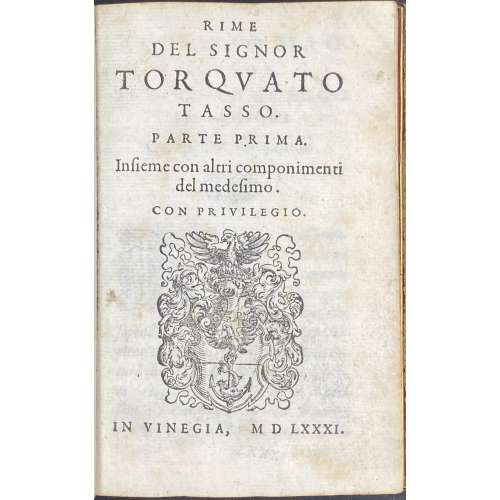 Title-page: RIME | DEL SIGNOR | TORQUATO | TASSO. | PARTE PRIMA. | Insieme con altri componimenti | del medesimo | CON PRIVILEGIO. | {publisher’s device} | IN VINEGIA, M D LXXXI. || Contents: 1. Rime; 2. Aminta favola boscareccia; 3. Conclusioni amorose; 4. Il Romeo, overo del Giuoco dialogo; 5. Lettera, nellaquale paragona l’Italia alla Francia; 6. All’eccellentis signor Duca di Urbino; 7. Dialogo del l’amor. Pagination: [2 blanks], [2] – t.p. / blank, [4] dedication, [2] – blank / content, [16] – tavola, [1] 2-160 – rime, [8] [1] 2-74 – aminta, [4] 1-9 [10 blank] – conclusion, [2] [1]-22 – dialogo, [2] 1-27 [28 blank] – lettera, [2] 1-4 – all’eccellentiss, [4 blanks], [2] 1-17 [18 blank] – dialogo del l’amor, [2] – Car. 52 / Car. 113., [4 blanks], total 372 pages. Collation: 8vo; first blank, *4, **8, A-K8, 2A-2L8 M4, last blank; total 186 leaves, incl. first and last blanks. Note: 2F2, 2G1, 2K4, 2L1, and 2M3,4 – unsigned. Binding: 15.2 x 10.3 cm, 19th-century polished calf by Duke St., St. James, London (ticket) Cambridge panels ruled in gilt with fleurons at corners, two crimson labels to spine with gilt lettering, gilt in compartments, raised bands ruled gilt, rebacked, AEG, bookplate to front pastedown: “BIBLIOTECA | del | Conte Leonardo Vitetti | Ambasciatore d’Italia” in a frame, and “The Robin Collection” to FEP. Inset a card from Bryn Mawr College Library. Provenance: Satinsky, Robin F. (American, 1919 – 2008), The Robin Collection. Count Leonardo Vitetti (Italian, 1895 – 1973) Bryn Mawr College Library (Pennsylvania) Contributors: Torquato Tasso (Italian, 1544 –1595) – author. Aldus Manutius, the Younger (Italian, 1547 – 1597) – printer, publisher.
Title-page: RIME | DEL SIGNOR | TORQUATO | TASSO. | PARTE PRIMA. | Insieme con altri componimenti | del medesimo | CON PRIVILEGIO. | {publisher’s device} | IN VINEGIA, M D LXXXI. || Contents: 1. Rime; 2. Aminta favola boscareccia; 3. Conclusioni amorose; 4. Il Romeo, overo del Giuoco dialogo; 5. Lettera, nellaquale paragona l’Italia alla Francia; 6. All’eccellentis signor Duca di Urbino; 7. Dialogo del l’amor. Pagination: [2 blanks], [2] – t.p. / blank, [4] dedication, [2] – blank / content, [16] – tavola, [1] 2-160 – rime, [8] [1] 2-74 – aminta, [4] 1-9 [10 blank] – conclusion, [2] [1]-22 – dialogo, [2] 1-27 [28 blank] – lettera, [2] 1-4 – all’eccellentiss, [4 blanks], [2] 1-17 [18 blank] – dialogo del l’amor, [2] – Car. 52 / Car. 113., [4 blanks], total 372 pages. Collation: 8vo; first blank, *4, **8, A-K8, 2A-2L8 M4, last blank; total 186 leaves, incl. first and last blanks. Note: 2F2, 2G1, 2K4, 2L1, and 2M3,4 – unsigned. Binding: 15.2 x 10.3 cm, 19th-century polished calf by Duke St., St. James, London (ticket) Cambridge panels ruled in gilt with fleurons at corners, two crimson labels to spine with gilt lettering, gilt in compartments, raised bands ruled gilt, rebacked, AEG, bookplate to front pastedown: “BIBLIOTECA | del | Conte Leonardo Vitetti | Ambasciatore d’Italia” in a frame, and “The Robin Collection” to FEP. Inset a card from Bryn Mawr College Library. Provenance: Satinsky, Robin F. (American, 1919 – 2008), The Robin Collection. Count Leonardo Vitetti (Italian, 1895 – 1973) Bryn Mawr College Library (Pennsylvania) Contributors: Torquato Tasso (Italian, 1544 –1595) – author. Aldus Manutius, the Younger (Italian, 1547 – 1597) – printer, publisher.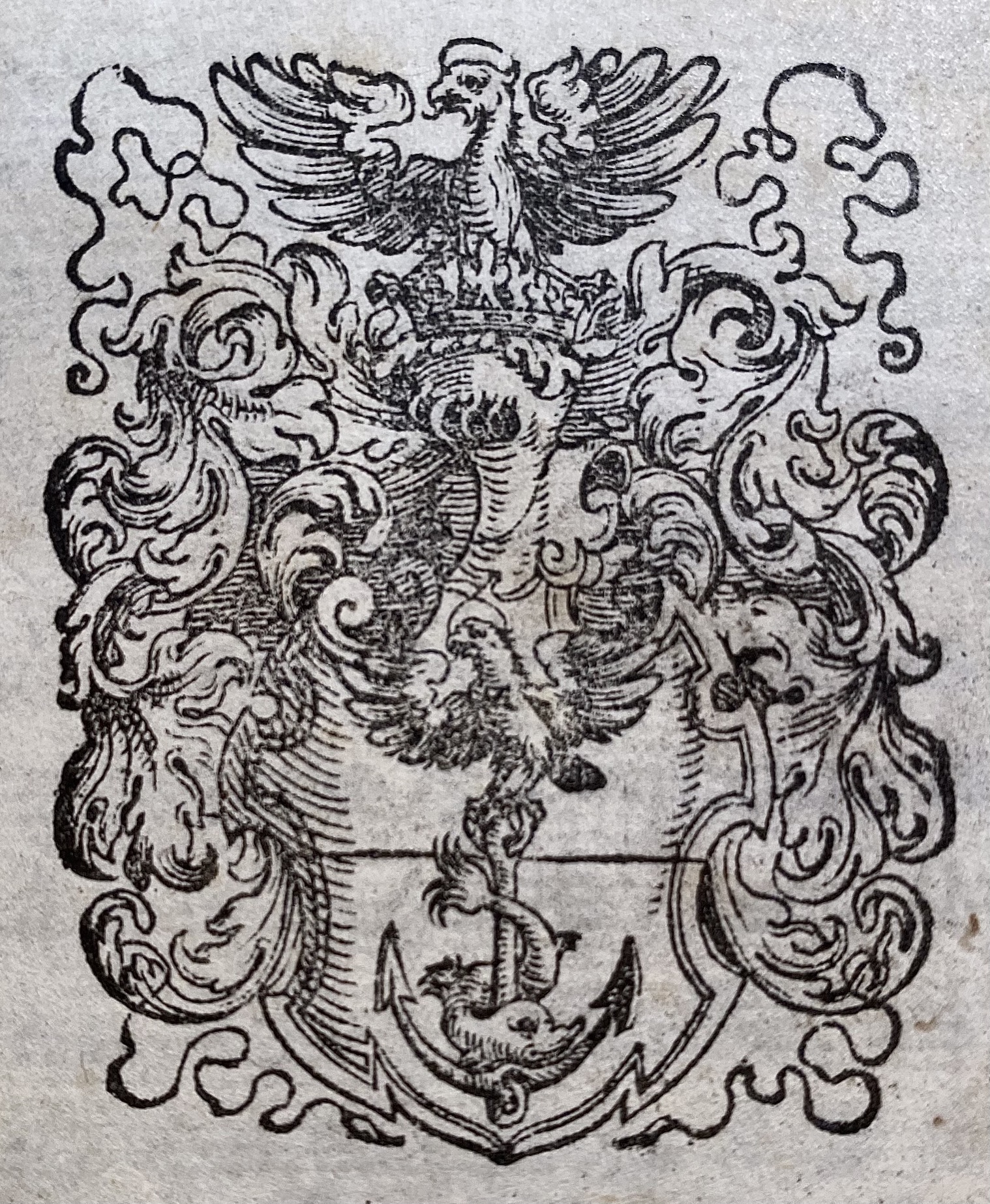
-
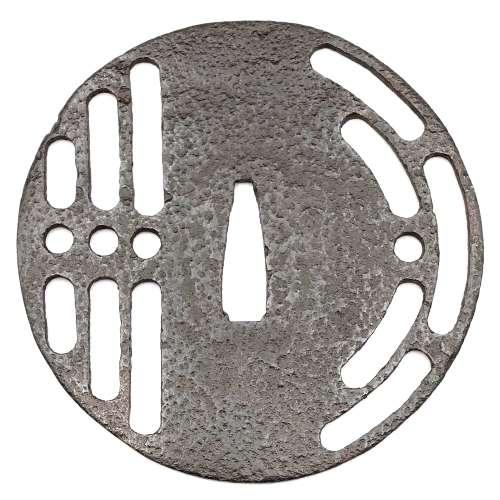 A very large and very thin iron tsuba of round form decorated with design of formalized butterfly and dragonfly in openwork (sukashi). The characteristics of the plate resemble those of Kamakura period ko-tōshō tsuba. However, the design seems too 'modern' to me, but it's hard to tell; it may be a late Muromachi or Momoyama period work. Tōshō or Ko-Tōshō school (or a Katchushi). Muromachi period. Dimensions: 99.6 x 100.5 x 2.1 mm. This is what Jim Gilbert says about old tsuba:
A very large and very thin iron tsuba of round form decorated with design of formalized butterfly and dragonfly in openwork (sukashi). The characteristics of the plate resemble those of Kamakura period ko-tōshō tsuba. However, the design seems too 'modern' to me, but it's hard to tell; it may be a late Muromachi or Momoyama period work. Tōshō or Ko-Tōshō school (or a Katchushi). Muromachi period. Dimensions: 99.6 x 100.5 x 2.1 mm. This is what Jim Gilbert says about old tsuba:"Traditionally the old iron plate tsuba are classified into Ko Tosho (old sword smith), and Ko Katchushi (old armor maker) styles. It is sometimes difficult to justify attribution of a given tsuba to the Tosho or Katchushi category. Generally guards with raised rims or relatively complex designs tend to be assigned to Katchushi. This is basically a convention we follow out of habit and convenience." [...] "In Token Kai-Shi part six, Articles by Akiyama Kyusaku, Robert Haynes comments: "…from 1300 to 1400 over 150,000 MOUNTED swords were made in Japan for export alone. This means that over four tsuba a day were made for 100 years. This would mean that at least 3000 persons were making nothing but tsuba, let alone all the other fittings needed to complete these swords. With sword smiths, fittings makers and all the other artists need to complete a sword for export, at least 10,000 sword artists were working together, in any one of these hundred years."
Reference to design can be found at "Japanese Swords and Tsuba from the Professor A. Z. Freeman and the Phyllis Sharpe Memorial collections" / Sotheby's, London, Thursday 10 April 1997; p. 18-19, lot № 37: "A Kamakura-bori Tsuba, Momoyama Period. ...pierced with two large formalised butterflies..."Reference to design in this collection: TSU-0319.
A Kamakura-bori tsuba of octagonal form, Momoyama period.

TSU-0319. Ōnin ten-zōgan tsuba, Muromachi period.
-
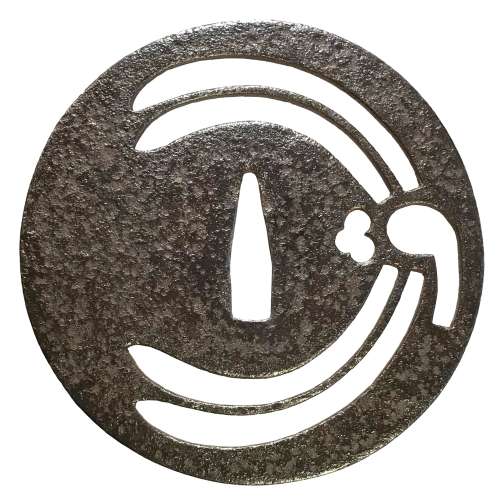 Iron tsuba of round form decorated with design of dragonfly in negative openwork (in-sukashi). It may be Ko-Tōshō (old Tōshō) or just Tōshō school, without a 'Ko'. Probably the dragonfly here is used as a family crest (mon). Muromachi period. Dimensions: Height: 95.0 mm. Width: 93.6 mm. Rim thickness: 2.1 mm. Center thickness: 2.3 mm. Nakago-ana: height = 30 mm, width = 7.8 mm. A dragonfly design is described by John W. Dower as following "During the period of feudal warfare, the dragonfly is reputed to have been am especially popular design applied to arrow quivers, and some warriors adopted it as a family crest. One reason for this was the insect's alternative names of katsu mushi and shogun mushi, both meaning 'victory insect'." Merrily Baird is even more talkative regarding the matter: "The dragonfly (tombo) in Japan is emblematic of martial success, as various names for the insect are homophones for words meaning "victory". The dragonfly is also auspicious because references in the Kojiki and Nihongi link it in both name and shape to the old kingdom of Yamato. This legacy has led to the use of dragonfly as an emblem on arrow quivers and as family crest. It also appears occasionally in conjunction with such imperial motifs as the chrysanthemum. Used in a context devoid of historical associations, the dragonfly is a seasonal symbol of late summer and early autumn." Dragonfly was an extremely often motif for the tsuba in all times, primarily in earlier times, before Tokugawa pacified the nation. The same motif is used on Ōnin tsuba in this collection:
Iron tsuba of round form decorated with design of dragonfly in negative openwork (in-sukashi). It may be Ko-Tōshō (old Tōshō) or just Tōshō school, without a 'Ko'. Probably the dragonfly here is used as a family crest (mon). Muromachi period. Dimensions: Height: 95.0 mm. Width: 93.6 mm. Rim thickness: 2.1 mm. Center thickness: 2.3 mm. Nakago-ana: height = 30 mm, width = 7.8 mm. A dragonfly design is described by John W. Dower as following "During the period of feudal warfare, the dragonfly is reputed to have been am especially popular design applied to arrow quivers, and some warriors adopted it as a family crest. One reason for this was the insect's alternative names of katsu mushi and shogun mushi, both meaning 'victory insect'." Merrily Baird is even more talkative regarding the matter: "The dragonfly (tombo) in Japan is emblematic of martial success, as various names for the insect are homophones for words meaning "victory". The dragonfly is also auspicious because references in the Kojiki and Nihongi link it in both name and shape to the old kingdom of Yamato. This legacy has led to the use of dragonfly as an emblem on arrow quivers and as family crest. It also appears occasionally in conjunction with such imperial motifs as the chrysanthemum. Used in a context devoid of historical associations, the dragonfly is a seasonal symbol of late summer and early autumn." Dragonfly was an extremely often motif for the tsuba in all times, primarily in earlier times, before Tokugawa pacified the nation. The same motif is used on Ōnin tsuba in this collection:
-
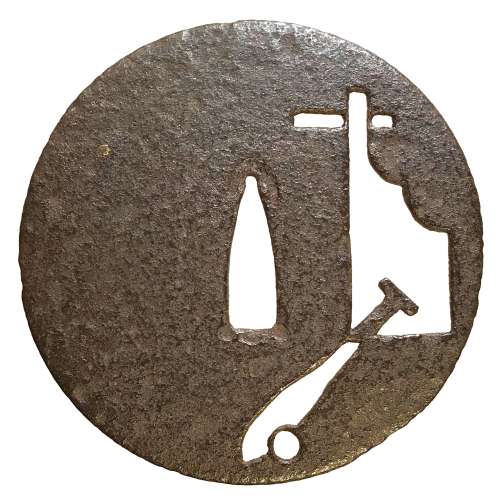 Round tsuba of iron; well forged thin plate decorated with a rudder (kaji) and an oar, or paddle (kai) with a water drop, executed in a combination of negative (in-sukashi) and positive (ji-sukashi) openwork. It may be Ko-Tōshō (old Tōshō) or just Tōshō school, without a 'Ko'. The characteristics of the plate point toward an older piece, however the combination of negative and positive silhouettes pulls the date of manufacture in an opposite direction. Muromachi period. Height: 90.0 mm. Width: 89.0 mm. Rim thickness: 2.1 mm. Center thickness: 2.3 mm. Nakago-ana: height = 29 mm, width = 8.8 mm. A rudder and an oar design is classified by John W. Dower as "Sailing vessels and gear": "Unlike many other motifs, sailing vessels and sailing gear failed to collect an interesting lore or to develop levels of meaning." Merrily Baird does not say anything about these symbols. Yuzuri Okada says: "Ships, sails, rudders, etc. also supply motive of the same class as wheels." He does not provide us with the description of the motive supplied by the wheel. The same motif is used on Ōnin tsuba in this collection:
Round tsuba of iron; well forged thin plate decorated with a rudder (kaji) and an oar, or paddle (kai) with a water drop, executed in a combination of negative (in-sukashi) and positive (ji-sukashi) openwork. It may be Ko-Tōshō (old Tōshō) or just Tōshō school, without a 'Ko'. The characteristics of the plate point toward an older piece, however the combination of negative and positive silhouettes pulls the date of manufacture in an opposite direction. Muromachi period. Height: 90.0 mm. Width: 89.0 mm. Rim thickness: 2.1 mm. Center thickness: 2.3 mm. Nakago-ana: height = 29 mm, width = 8.8 mm. A rudder and an oar design is classified by John W. Dower as "Sailing vessels and gear": "Unlike many other motifs, sailing vessels and sailing gear failed to collect an interesting lore or to develop levels of meaning." Merrily Baird does not say anything about these symbols. Yuzuri Okada says: "Ships, sails, rudders, etc. also supply motive of the same class as wheels." He does not provide us with the description of the motive supplied by the wheel. The same motif is used on Ōnin tsuba in this collection:
-
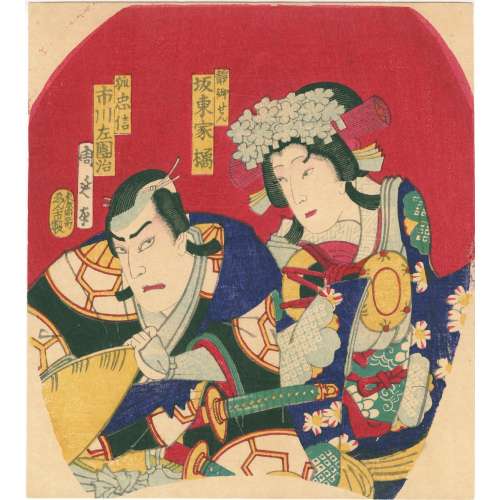 Artist: Toyohara Chikanobu [豊原周延] (Japanese, 1838 – 1912) Signed: Chikanobu ga [周延画] Publisher: [ 東京掘江町] Tokyo Horiemachi | [えん市製] Enshi-sei. Media: Fan print (uchiwa-e, 団扇絵), 192 x 172 mm. Actors: Female: Bandō Kakitsu I in the role of Shizuka Gozen [静御前]. Male: Ichikawa Sadanji I in the role of Kitsune Tadanobu [狐忠信], a.k.a. Satō Tadanobu [佐藤 忠信]. Bandō Kakitsu I [初代 坂東 家橘] (Japanese, 1847 – 1893); other names: Ichimura Kakitsu V, Ichimura Uzaemon XIV, Ichimura Kakitsu V, Ichimura Uzaemon XIV, Ichimura Takematsu III. Ichikawa Sadanji I [市川左団次] (Japanese, 1842 – 1904); other names: Ichikawa Shōjaku I, Ichikawa Koyone, Ichikawa Tatsuzō.
Artist: Toyohara Chikanobu [豊原周延] (Japanese, 1838 – 1912) Signed: Chikanobu ga [周延画] Publisher: [ 東京掘江町] Tokyo Horiemachi | [えん市製] Enshi-sei. Media: Fan print (uchiwa-e, 団扇絵), 192 x 172 mm. Actors: Female: Bandō Kakitsu I in the role of Shizuka Gozen [静御前]. Male: Ichikawa Sadanji I in the role of Kitsune Tadanobu [狐忠信], a.k.a. Satō Tadanobu [佐藤 忠信]. Bandō Kakitsu I [初代 坂東 家橘] (Japanese, 1847 – 1893); other names: Ichimura Kakitsu V, Ichimura Uzaemon XIV, Ichimura Kakitsu V, Ichimura Uzaemon XIV, Ichimura Takematsu III. Ichikawa Sadanji I [市川左団次] (Japanese, 1842 – 1904); other names: Ichikawa Shōjaku I, Ichikawa Koyone, Ichikawa Tatsuzō. -
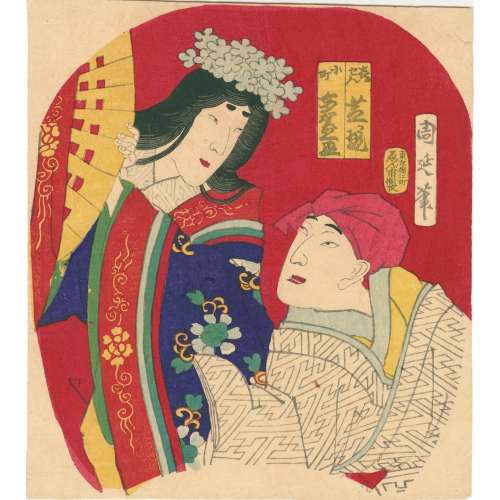 Artist: Toyohara Chikanobu [豊原周延] (Japanese, 1838 – 1912) Signed: Chikanobu hitsu [周延筆] Publisher: [ 東京掘江町] Tokyo Horiemachi | [えん市製] Enshi-sei. Media: Fan print (uchiwa-e, 団扇絵), 192 x 172 mm. Possibly Iwai Kumesaburō IV [岩井粂三郎] (1856 – 1886) a.k.a. Iwai Hisajirō III [岩井久次郎] in the role of Ono no Komachi [小野乃小町] and Nakamura Shikan IV [中村芝翫] in the role of Kisen Hōshi [喜せん法師]. Play: The Six Immortal Poets in Colorful Guises [六歌仙体綵] (Rokkasen Sugata no irodori). Inscription: Left: Kisen [喜せん] | Shikan [芝翫] Right: Komachi [小町] | Kumesaburō [粂三郎]. Actors: Iwai Kumesaburō IV [岩井粂三郎] (1856 – 1886) a.k.a. Iwai Hisajirō III [岩井久次郎]. Nakamura Shikan IV [中村芝翫] (Japanese, 1831 – 1899); other names: Nakamura Fukusuke I [中村福助], Nakamura Masanosuke I, Nakamura Komasaburō, Nakamura Tamatarō I.
Artist: Toyohara Chikanobu [豊原周延] (Japanese, 1838 – 1912) Signed: Chikanobu hitsu [周延筆] Publisher: [ 東京掘江町] Tokyo Horiemachi | [えん市製] Enshi-sei. Media: Fan print (uchiwa-e, 団扇絵), 192 x 172 mm. Possibly Iwai Kumesaburō IV [岩井粂三郎] (1856 – 1886) a.k.a. Iwai Hisajirō III [岩井久次郎] in the role of Ono no Komachi [小野乃小町] and Nakamura Shikan IV [中村芝翫] in the role of Kisen Hōshi [喜せん法師]. Play: The Six Immortal Poets in Colorful Guises [六歌仙体綵] (Rokkasen Sugata no irodori). Inscription: Left: Kisen [喜せん] | Shikan [芝翫] Right: Komachi [小町] | Kumesaburō [粂三郎]. Actors: Iwai Kumesaburō IV [岩井粂三郎] (1856 – 1886) a.k.a. Iwai Hisajirō III [岩井久次郎]. Nakamura Shikan IV [中村芝翫] (Japanese, 1831 – 1899); other names: Nakamura Fukusuke I [中村福助], Nakamura Masanosuke I, Nakamura Komasaburō, Nakamura Tamatarō I. -
 Iron tsuba of the round form (丸型, maru–gata), decorated with brass flat inlay (平象嵌, hira-zōgan) of bellflowers, leaves, and vines on both sides, inlaid brass is carved in low relief; wide rim (dote-mimi) also inlaid; the plate is pierced with hitsu-ana (probably original); nakago-ana plugged with copper sekigane. Dimensions: Height: 84.1 mm; Width: 82.0 mm; Thickness (centre): 2.8 mm; mimi is 11.8 mm wide and 4.7 mm thick. Produced at the end of the 16th century, in the Momoyama period (1674–1703).
Iron tsuba of the round form (丸型, maru–gata), decorated with brass flat inlay (平象嵌, hira-zōgan) of bellflowers, leaves, and vines on both sides, inlaid brass is carved in low relief; wide rim (dote-mimi) also inlaid; the plate is pierced with hitsu-ana (probably original); nakago-ana plugged with copper sekigane. Dimensions: Height: 84.1 mm; Width: 82.0 mm; Thickness (centre): 2.8 mm; mimi is 11.8 mm wide and 4.7 mm thick. Produced at the end of the 16th century, in the Momoyama period (1674–1703). -
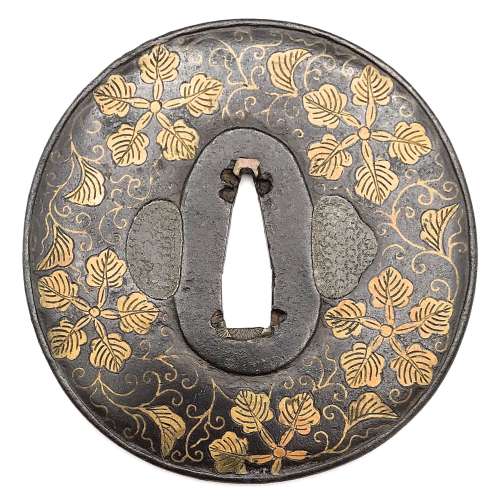 Iron tsuba of slightly elongated round form decorated with design of melon flowers, vines, and leaves in brass flat inlay (hira-zōgan) on both sides. Slightly raised rim (mimi) carved in a way to simulate ring-shaped covering (fukurin). Kozuka hitsu-ana and kogai hitsu-ana both plugged with soft metal (tim or lead). Copper sekigane. Heianjō or Kaga School. Muromachi or Momoyama period, 16th century. Iron, hira-zōgan brass inlay. Round (maru gata) form, diameter 79 mm. Size: 80.3 x 78.4 mm; thickness at seppa-dai: 3.4 mm; at the middle: 3.8 mm; before the rim: 2.4 mm, rim: 2.8 mm. Note on design: though this design resembles family crests with oak and mulberry leaves, I believe it's a melon flower [see Jeanne Allen. Designer's guide to Samurai Patterns. Chronicle Books, San Francisco, 1990, page 114, №130 "Melon Flowers":Note about the distribution of thickness (niku-oki): "this tsuba has toroid features, niku raises from the rim towards the centre but thins once more out when approaching the seppa-dai" [M. Sesko, "Handbook...", p. 48].
Iron tsuba of slightly elongated round form decorated with design of melon flowers, vines, and leaves in brass flat inlay (hira-zōgan) on both sides. Slightly raised rim (mimi) carved in a way to simulate ring-shaped covering (fukurin). Kozuka hitsu-ana and kogai hitsu-ana both plugged with soft metal (tim or lead). Copper sekigane. Heianjō or Kaga School. Muromachi or Momoyama period, 16th century. Iron, hira-zōgan brass inlay. Round (maru gata) form, diameter 79 mm. Size: 80.3 x 78.4 mm; thickness at seppa-dai: 3.4 mm; at the middle: 3.8 mm; before the rim: 2.4 mm, rim: 2.8 mm. Note on design: though this design resembles family crests with oak and mulberry leaves, I believe it's a melon flower [see Jeanne Allen. Designer's guide to Samurai Patterns. Chronicle Books, San Francisco, 1990, page 114, №130 "Melon Flowers":Note about the distribution of thickness (niku-oki): "this tsuba has toroid features, niku raises from the rim towards the centre but thins once more out when approaching the seppa-dai" [M. Sesko, "Handbook...", p. 48].
Jeanne Allen. Designer's guide to Samurai Patterns. Chronicle Books, San Francisco, 1990. Page 114, №130.
-
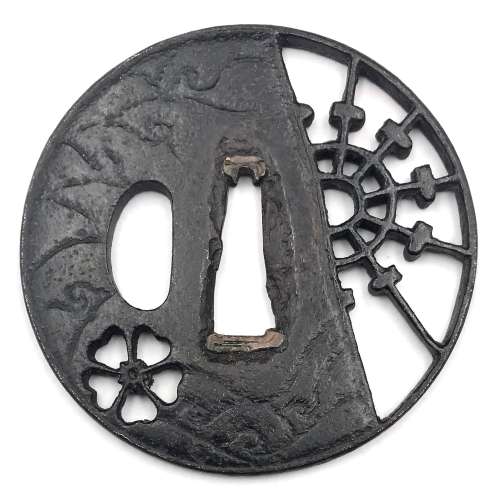 Iron tsuba of round form decorated with design of sea waves in low relief carving (kebori) and pierced with design of cherry blossom in negative silhouette (in-sukashi) and water wheel in positive silhouette (ji-sukashi). The solid portion of the plate has a shallow groove just before the edge. Copper sekigane. School attribution is unclear. Unsigned. Momoyama period, 16th - 17th century. Dimensions: Height: 70.3 mm, width: 71.1 mm, thickness at seppa-dai: 4.4 mm, at rim 4.1 mm. Provenance: Robert E. Haynes, Mark Weisman. This is what shibuiswords.com says about this tsuba:
Iron tsuba of round form decorated with design of sea waves in low relief carving (kebori) and pierced with design of cherry blossom in negative silhouette (in-sukashi) and water wheel in positive silhouette (ji-sukashi). The solid portion of the plate has a shallow groove just before the edge. Copper sekigane. School attribution is unclear. Unsigned. Momoyama period, 16th - 17th century. Dimensions: Height: 70.3 mm, width: 71.1 mm, thickness at seppa-dai: 4.4 mm, at rim 4.1 mm. Provenance: Robert E. Haynes, Mark Weisman. This is what shibuiswords.com says about this tsuba:"A very unusual iron plate tsuba. The solid plate is carved with waves on both sides. A cherry bloom in sukashi, lower left, and the right third of the plate in openwork with design of a water wheel. The rim with some iron bones. The hitsu-ana is original but the shape may have been slightly changed. One would expect this to be the work of the early Edo period, but the age of the walls of the sukashi would suggest that this is a work of the middle Muromachi period. This must be the forerunner for the Edo examples we see of this type of design." (Haynes)
I managed to find a look-a-like tsuba in Haynes Catalog #5, 1983, pp. 20-21, №44: "Typical later Heianjo brass inlay example. Ca. 1725. Ht. 7 cm., Th. 4.5 mm., $100/200".We see that the plate design of both tsuba is the same, and the only difference is the trim. It would be logical to assume that both pieces were made at about the same time, rather than 225 years apart. To be fair, let's accept that they were made in Momoyama period.
Haynes Catalog #5, 1983, pp. 20-21, №44.
-
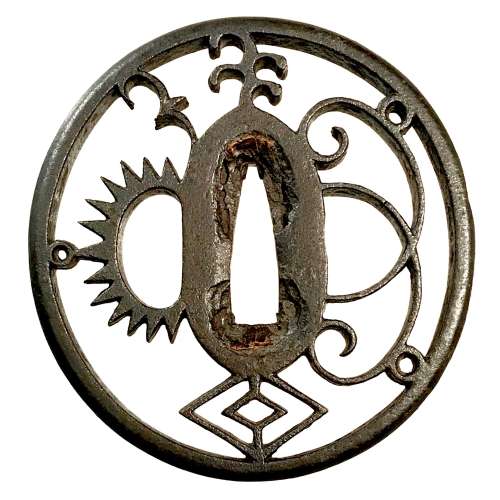 Iron tsuba of round form with a dense combination of symbols: slanting rays of light (shakoh) Christian motif (Jesuit's IHS symbol), also often described as "tokei" or "clock gear", wild goose in flight, bracken, and lozenges in openwork (sukashi). Copper sekigane. Edo period.
Iron tsuba of round form with a dense combination of symbols: slanting rays of light (shakoh) Christian motif (Jesuit's IHS symbol), also often described as "tokei" or "clock gear", wild goose in flight, bracken, and lozenges in openwork (sukashi). Copper sekigane. Edo period.Size: 76.0 x 72.6 x 6.2 mm
Unsigned.
For information regarding shakoh tsuba see article 'Kirishitan Ikenie Tsuba by Fred Geyer at Kokusai Tosogu Kai; The 2nd International Convention & Exhibition, October 18-23, 2006, pp. 84-91.
-
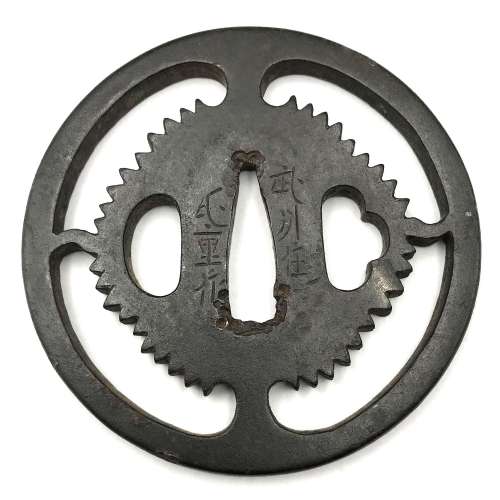 Iron tsuba of round form with slanting rays of light (shakoh) Christian motif (Jesuit's IHS symbol) in openwork (sukashi). Traditional description of this kind of design is called "tokei", or "clock gear". Edo period.
Iron tsuba of round form with slanting rays of light (shakoh) Christian motif (Jesuit's IHS symbol) in openwork (sukashi). Traditional description of this kind of design is called "tokei", or "clock gear". Edo period.Size: 83.4 x 83.1 x 4.4 mm
Signed Bushū-jū Ujishige saku (武州住氏重作) [Markus Sesko]. Ujishige (died 1677), 3rd generation of the Katsuki-Gondayu line; 1st gen. Ujiie came from Kyoto to Kaga to work for the Maeda family. There was another Ujishige, 4th generation Kaneko (?), who died in 1867 [M. Sesko, Genealogies...], but this tsuba looks a bit earlier than that. This particular Ujishige states in his signature that he is from Bushū, or Musashi Province, modern Tokyo Metropolis. He might have moved from Bushū to Kaga, of course. There is no artist with the name Ujishige in Bushū-Ito School anyway.
For information regarding shakoh tsuba see article 'Kirishitan Ikenie Tsuba by Fred Geyer at Kokusai Tosogu Kai; The 2nd International Convention & Exhibition, October 18-23, 2006, pp. 84-91.


